Paul van Yperen's Blog, page 290
November 10, 2017
Editions Pathé Frères (2)
Last Saturday, EFSP did a post on an early series by Edition Pathé Frères of black and white postcards, made just before the First World War. Today we have a series of hand-coloured postcards of the Pathé stars of the 1910s. Among them were Stacia Napierkowska, Robinne and Léontine Massart. And the biggest star of them all was the marvellous comedian Max Linder. His and other photos were made by Félix. The postcards were printed by the Imprimerie de la Platinogravure.
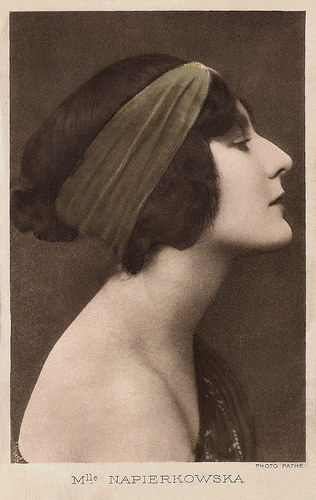
Stacia Napierkowska . French postcard. Photo: Pathé.
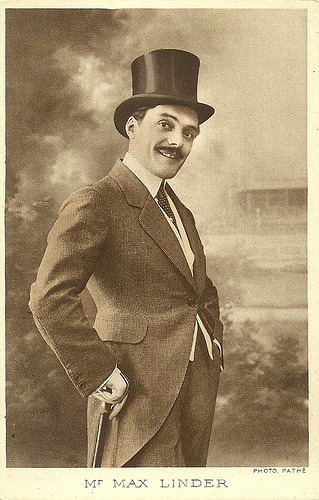
Max Linder . French postcard. Photo: Pathé.
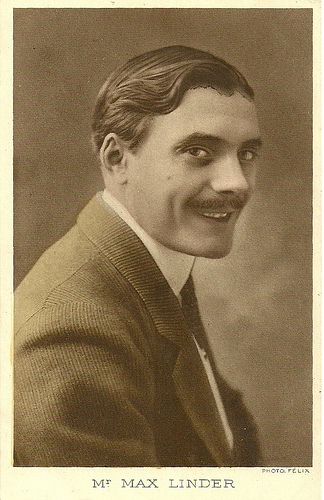
Max Linder . French postcard. Photo: Félix.
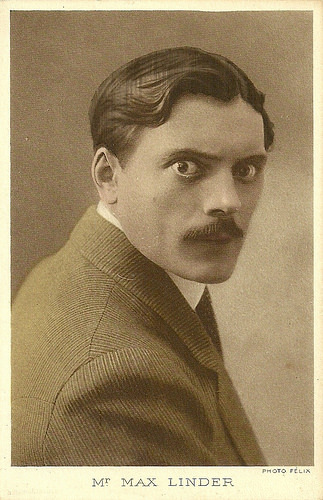
Max Linder . French postcard. Photo: Félix.
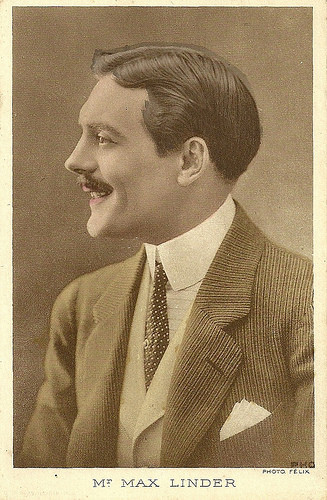
Max Linder . French postcard. Photo: Félix.
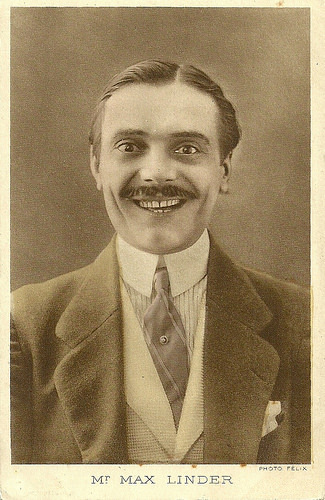
Max Linder . French postcard. Photo: Félix .
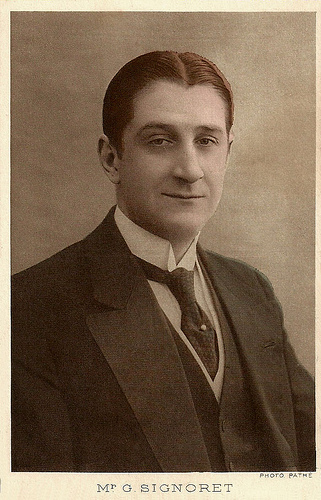
Gabriel Signoret . French postcard. Photo: Pathé.
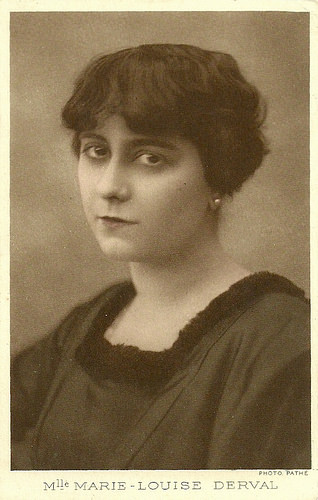
Marie-Louise Derval. French postcard. Photo: Pathé.
French stage and (silent) screen actress Marie-Louise Derval peaked in the early 1910s in Pathé films by a.o. Albert Capellani and in Eclair films by Emile Chautard. In the later 1910s she acted in many films by André Hugon for Les Films Succès.
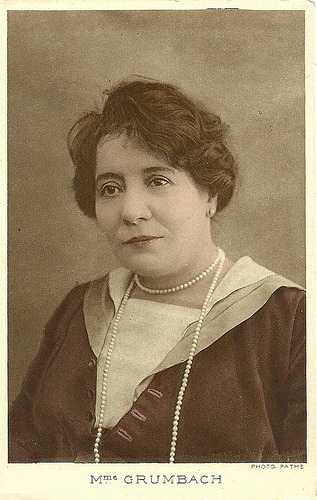
Jeanne Grumbach. French postcard. Photo: Pathé.
Jeanne Grumbach (1871-1947) was a French stage and (silent) screen actress, who played in many early Pathé films.
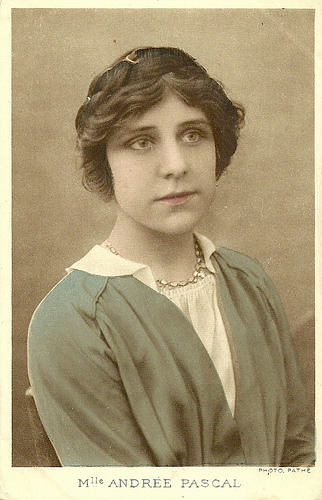
Andrée Pascal. French postcard. Photo: Pathé.
Andrée Pascal (1892-1982) was a French actress who was highly active in French silent cinema. She did over 30 films for Pathé in the early 1910s, but suddenly stopped her film career after acting in L'empereur des pauvres (1922).
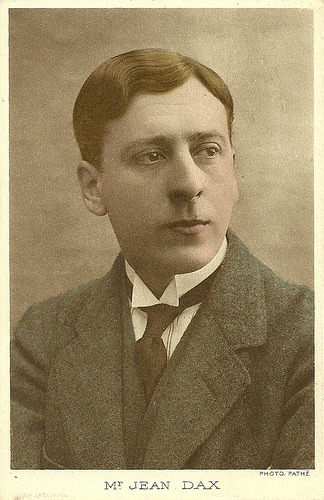
Jean Dax . French postcard. Photo: Pathé.
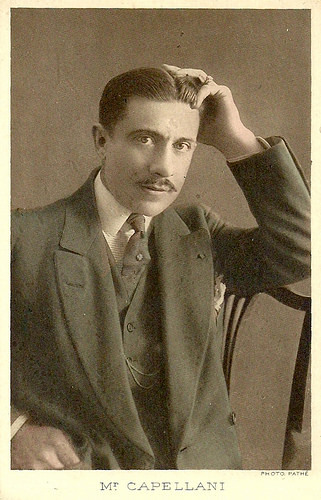
Paul Capellani . French postcard. Photo: Pathé.
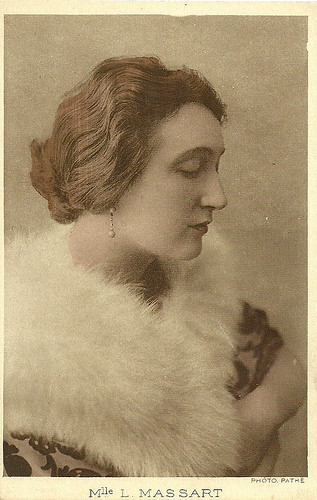
Léontine Massart . French postcard. Photo: Pathé.
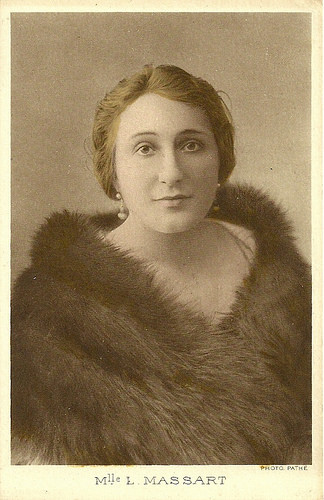
Léontine Massart . French postcard. Photo: Pathé.
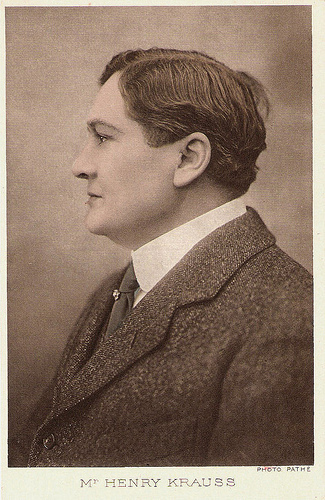
Henry Krauss . French postcard. Photo: Pathé.
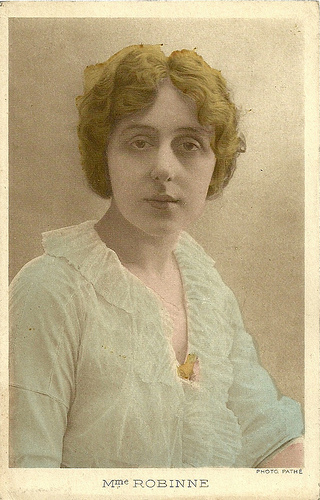
Gabrielle Robinne . French postcard. Photo: Pathé.
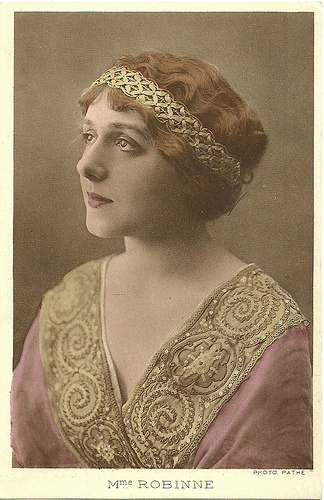
Gabrielle Robinne . French postcard. Photo: Pathé.
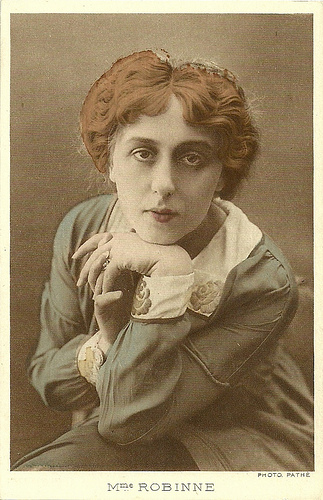
Gabrielle Robinne . French postcard. Photo: Pathé.
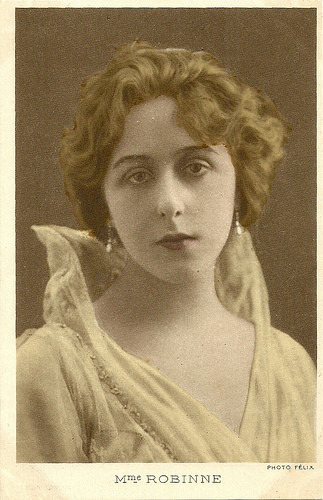
Gabrielle Robinne . French postcard. Photo: Félix.
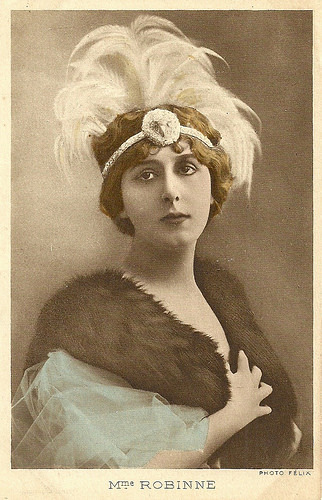
Gabrielle Robinne . French postcard. Photo: Félix.
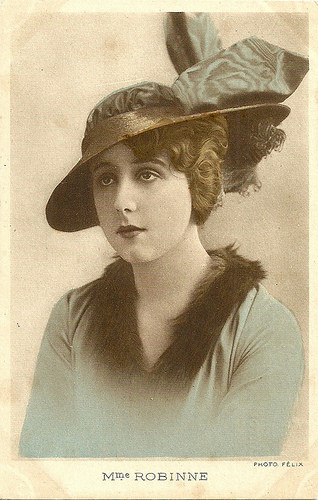
Gabrielle Robinne . French postcard. Photo: Félix.
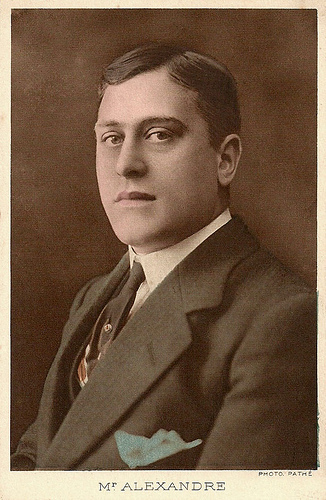
René Alexandre . French postcard. Photo: Pathé.
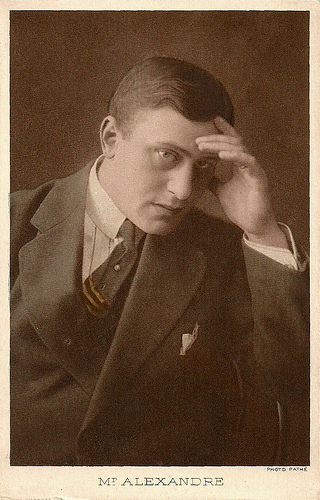
René Alexandre . French postcard. Photo: Pathé.
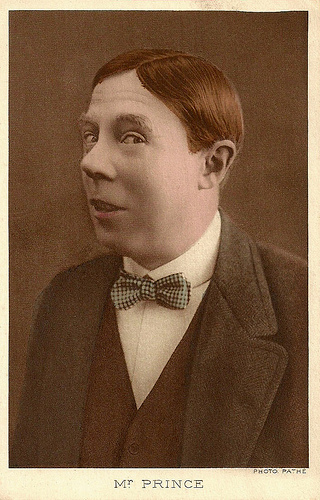
Charles Prince . French postcard. Photo: Pathé.
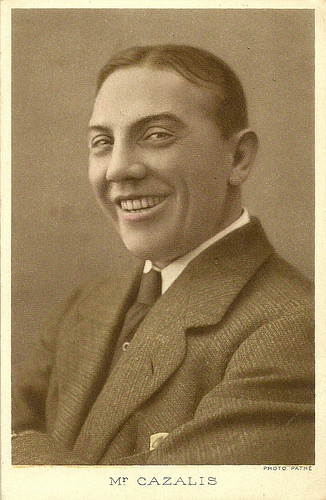
Cazalis. French postcard. Photo: Pathé.
Lucien Cazalis (1978-1945) was a French comedian, who starred in dozens of short Pathé farces between 1910 and 1916. First he was called Jobard in his films, later he was named Caza.

Stacia Napierkowska . French postcard. Photo: Pathé.

Max Linder . French postcard. Photo: Pathé.

Max Linder . French postcard. Photo: Félix.

Max Linder . French postcard. Photo: Félix.

Max Linder . French postcard. Photo: Félix.

Max Linder . French postcard. Photo: Félix .

Gabriel Signoret . French postcard. Photo: Pathé.

Marie-Louise Derval. French postcard. Photo: Pathé.
French stage and (silent) screen actress Marie-Louise Derval peaked in the early 1910s in Pathé films by a.o. Albert Capellani and in Eclair films by Emile Chautard. In the later 1910s she acted in many films by André Hugon for Les Films Succès.

Jeanne Grumbach. French postcard. Photo: Pathé.
Jeanne Grumbach (1871-1947) was a French stage and (silent) screen actress, who played in many early Pathé films.

Andrée Pascal. French postcard. Photo: Pathé.
Andrée Pascal (1892-1982) was a French actress who was highly active in French silent cinema. She did over 30 films for Pathé in the early 1910s, but suddenly stopped her film career after acting in L'empereur des pauvres (1922).

Jean Dax . French postcard. Photo: Pathé.

Paul Capellani . French postcard. Photo: Pathé.

Léontine Massart . French postcard. Photo: Pathé.

Léontine Massart . French postcard. Photo: Pathé.

Henry Krauss . French postcard. Photo: Pathé.

Gabrielle Robinne . French postcard. Photo: Pathé.

Gabrielle Robinne . French postcard. Photo: Pathé.

Gabrielle Robinne . French postcard. Photo: Pathé.

Gabrielle Robinne . French postcard. Photo: Félix.

Gabrielle Robinne . French postcard. Photo: Félix.

Gabrielle Robinne . French postcard. Photo: Félix.

René Alexandre . French postcard. Photo: Pathé.

René Alexandre . French postcard. Photo: Pathé.

Charles Prince . French postcard. Photo: Pathé.

Cazalis. French postcard. Photo: Pathé.
Lucien Cazalis (1978-1945) was a French comedian, who starred in dozens of short Pathé farces between 1910 and 1916. First he was called Jobard in his films, later he was named Caza.
Published on November 10, 2017 22:00
November 9, 2017
Romanticismo (1915)
The Italian silent film Romanticismo (Carlo Campogalliani, Arrigo Frusta, 1915) was a production of Società Anonima Ambrosio, based on a famous play by Gerolamo Rovetta. Romanticismo was the film debut of diva Helena Makowska.
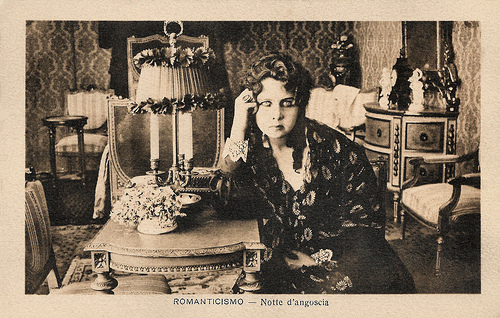
Italian postcard by IPA CT, no. 750. Photo: Film della Società Anonima Ambrosio, Torino. Publicity still for Romanticismo (1915) with Helena Makowksa . Caption: 'Night of anguish'.
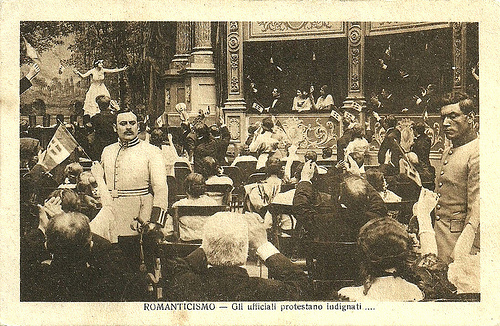
Italian postcard by IPA CT, no. 741. Photo: Film della Società Anonima Ambrosio, Torino. Publicity still for Romanticismo (1915). Caption: "The officers indignantly protest..." The scene represents the same scene with which Luchino Visconti opened his film Senso (1954): during an Italian opera performance a patriottic, anti-Austrian manifestation happens.
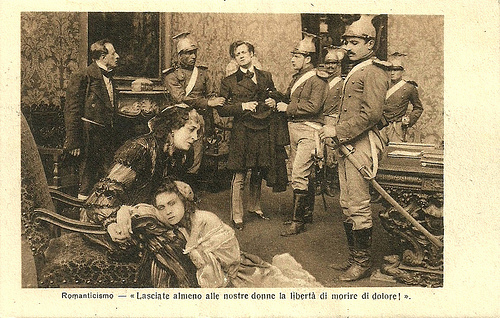
Italian postcard by IPA CT, no. 742. Photo: Film della Società Anonima Ambrosio, Torino. IPA CT. Publicity still for Romanticismo (1917) with Count Vitaliano Lamberti ( Tullio Carminati ) who is arrested by the Austrians, while his mother ( Mary Cléo Tarlarini ) and his wife ( Helena Makowksa ) cannot help. Caption: "At least permit our women the liberty to die of sorrow!"
Vengeful Lover
Romanticismo is situated in Lombardo-Veneto, in 1854. Polish singer and actress Helena Makowksa played Anna Lamberti.
Her husband, count Vitaliano Lamberti ( Tullio Carminati ), would like to join the partizans, but he is withheld by his mother ( Mary Cléo Tarlarini ), a fervent supporter of the Austrians.
His indecision has estranged him from his wife, who has an affair with a Polish profugee, Cezky, Vitaliano's secretary. When Vitaliano finally joins the free-fighting patriots, he regains his wife's confidence. Her vengeful lover denounces Vitaliano to the police, and then commits suicide.
When warned about his upcoming arrest, the count does not save himself but instead helps the young Giacomino ( Domenico Serra ) to escape. Lamberti is caught and executed.
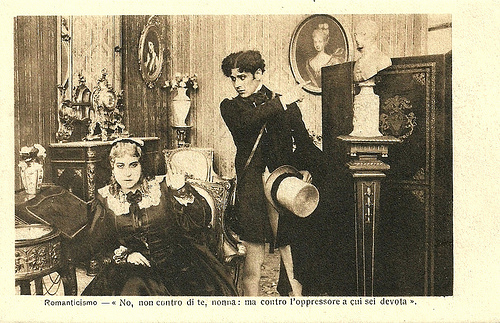
Italian postcard by IPA CT, no. 743. Photo: Film della Società Anonima Ambrosio, Torino. Publicity still for Romanticismo (1915) with Giacomino ( Domenico Serra ) who dislikes the pro-Austrian attitude of his grandmother ( Mary Cléo Tarlarini ). Caption: "No, grandmother, not against you; but against the oppressor to which you are devoted."
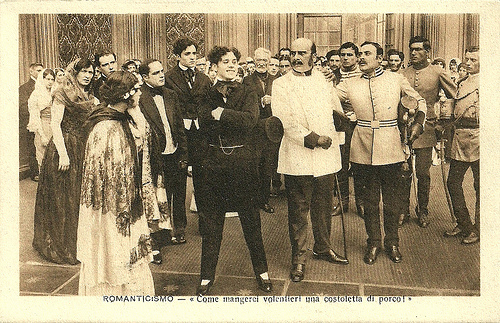
Italian postcard by IPA CT, no. 744. Photo: Film della Società Anonima Ambrosio, Torino. Publicity still for Romanticismo (1915) with Giacomino ( Domenico Serra ), who defies the Austrian officers. Caption: "How I'd love to eat some pork chops!".
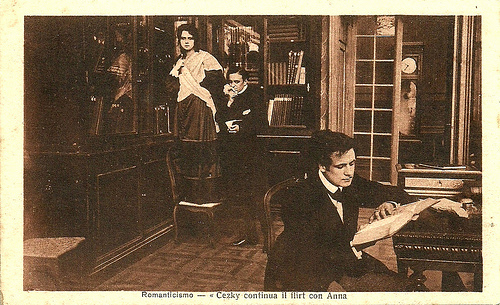
Italian postcard by IPA CT, no. 745. Photo: Film della Società Anonima Ambrosio, Torino. Publicity still for Romanticismo (1915). Caption: "Cezky (Giuseppe De Vivo) flirts with Anna Lamberti ( Helena Makowksa ). On the foreground an unsuspecting Tullio Carminati aka count Vitaliano Lamberti, her husband."
First World War
In Romanticismo (1915), we are in Northern Italy, 1854. The film premiered in Italy in September 1915, just a few months after the country had joined the Allied forces against Austria-Hungary and Germany in the First World War (April 1915).
For Helena Makowksa , Romanticismo (1915) meant her breakthrough in the cinema. In 1914, she had made her stage debut in the world of Opera, as Amelia in Giuseppe Verdi's Un Ballo in maschera (A Masked Ball) and Elena in Arrigo Boito's Mefistofele.
Producer Arturo Ambrosio had offered her a three-year contract, and between 1915 and 1920, Makowska went on to make some thirty silent Italian films .
The play Romanticismo by Gerolamo Rovetta, on which the film was based, would be refilmed by Clemente Fracassi Romanticismo (1949) starring Clara Calamai, Amedeo Nazzari and Fosco Giachetti .
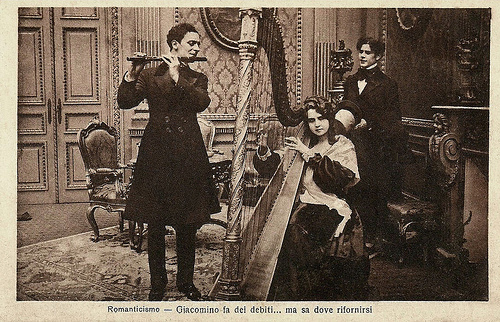
Italian postcard by IPA CT, no. 747. Photo: Film della Società Anonima Ambrosio, Torino. Publicity still for Romanticismo (1915) with Helena Makowksa (Anna Lamberti), Tullio Carminati (count Vitaliano Lamberti) and Domenico Serra (Giacomino). The caption: "Giacomino makes debts... but knows where to find funds to repay them."

Italian postcard by IPA CT, no. 748. Photo: Film della Società Anonima Ambrosio, Torino. Publicity still for Romanticismo (1915) with Tullio Carminati . The caption: "Friday Night".
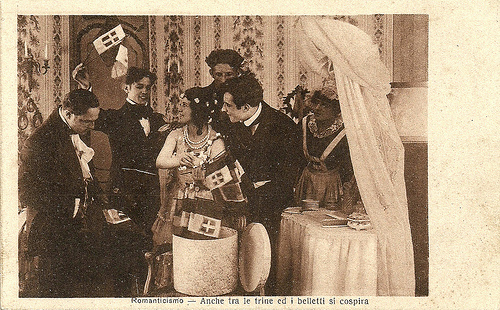
Italian postcard by IPA CT, no. 749. Photo: Film della Società Anonima Ambrosio, Torino. Publicity still for Romanticismo (1915) with Domenico Serra . Caption: "There is also conspiration among the flags and frills."
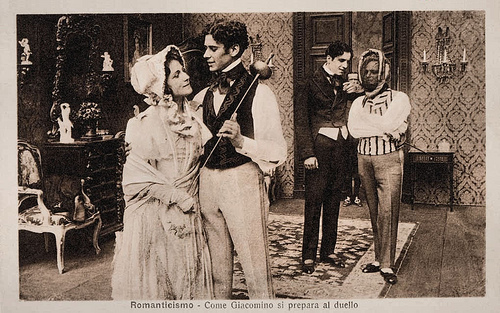
Italian postcard by IPA CT. Photo: Film della Società Anonima Ambrosio, Torino. Publicity still for Romanticismo (1915). Caption: "How Giacomino prepares for the Duel". Collection: Gino Federici.
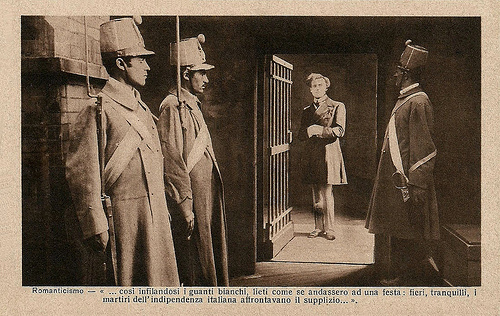
Italian postcard by IPA CT, no. 752. Photo: Film della Società Anonima Ambrosio, Torino. Still for Romanticismo (1915) with Tullio Carminati . Caption: "Thus their hands tucked in their white gloves, cheerful as if going to a party, proud and calm, the martyrs of Italian independence meet their ordeal".
Source: Angela Dalle Vacche (Diva: Defiance and Passion in Early Italian Cinema), Wikipedia (Italian) and IMDb.

Italian postcard by IPA CT, no. 750. Photo: Film della Società Anonima Ambrosio, Torino. Publicity still for Romanticismo (1915) with Helena Makowksa . Caption: 'Night of anguish'.

Italian postcard by IPA CT, no. 741. Photo: Film della Società Anonima Ambrosio, Torino. Publicity still for Romanticismo (1915). Caption: "The officers indignantly protest..." The scene represents the same scene with which Luchino Visconti opened his film Senso (1954): during an Italian opera performance a patriottic, anti-Austrian manifestation happens.

Italian postcard by IPA CT, no. 742. Photo: Film della Società Anonima Ambrosio, Torino. IPA CT. Publicity still for Romanticismo (1917) with Count Vitaliano Lamberti ( Tullio Carminati ) who is arrested by the Austrians, while his mother ( Mary Cléo Tarlarini ) and his wife ( Helena Makowksa ) cannot help. Caption: "At least permit our women the liberty to die of sorrow!"
Vengeful Lover
Romanticismo is situated in Lombardo-Veneto, in 1854. Polish singer and actress Helena Makowksa played Anna Lamberti.
Her husband, count Vitaliano Lamberti ( Tullio Carminati ), would like to join the partizans, but he is withheld by his mother ( Mary Cléo Tarlarini ), a fervent supporter of the Austrians.
His indecision has estranged him from his wife, who has an affair with a Polish profugee, Cezky, Vitaliano's secretary. When Vitaliano finally joins the free-fighting patriots, he regains his wife's confidence. Her vengeful lover denounces Vitaliano to the police, and then commits suicide.
When warned about his upcoming arrest, the count does not save himself but instead helps the young Giacomino ( Domenico Serra ) to escape. Lamberti is caught and executed.

Italian postcard by IPA CT, no. 743. Photo: Film della Società Anonima Ambrosio, Torino. Publicity still for Romanticismo (1915) with Giacomino ( Domenico Serra ) who dislikes the pro-Austrian attitude of his grandmother ( Mary Cléo Tarlarini ). Caption: "No, grandmother, not against you; but against the oppressor to which you are devoted."

Italian postcard by IPA CT, no. 744. Photo: Film della Società Anonima Ambrosio, Torino. Publicity still for Romanticismo (1915) with Giacomino ( Domenico Serra ), who defies the Austrian officers. Caption: "How I'd love to eat some pork chops!".

Italian postcard by IPA CT, no. 745. Photo: Film della Società Anonima Ambrosio, Torino. Publicity still for Romanticismo (1915). Caption: "Cezky (Giuseppe De Vivo) flirts with Anna Lamberti ( Helena Makowksa ). On the foreground an unsuspecting Tullio Carminati aka count Vitaliano Lamberti, her husband."
First World War
In Romanticismo (1915), we are in Northern Italy, 1854. The film premiered in Italy in September 1915, just a few months after the country had joined the Allied forces against Austria-Hungary and Germany in the First World War (April 1915).
For Helena Makowksa , Romanticismo (1915) meant her breakthrough in the cinema. In 1914, she had made her stage debut in the world of Opera, as Amelia in Giuseppe Verdi's Un Ballo in maschera (A Masked Ball) and Elena in Arrigo Boito's Mefistofele.
Producer Arturo Ambrosio had offered her a three-year contract, and between 1915 and 1920, Makowska went on to make some thirty silent Italian films .
The play Romanticismo by Gerolamo Rovetta, on which the film was based, would be refilmed by Clemente Fracassi Romanticismo (1949) starring Clara Calamai, Amedeo Nazzari and Fosco Giachetti .

Italian postcard by IPA CT, no. 747. Photo: Film della Società Anonima Ambrosio, Torino. Publicity still for Romanticismo (1915) with Helena Makowksa (Anna Lamberti), Tullio Carminati (count Vitaliano Lamberti) and Domenico Serra (Giacomino). The caption: "Giacomino makes debts... but knows where to find funds to repay them."

Italian postcard by IPA CT, no. 748. Photo: Film della Società Anonima Ambrosio, Torino. Publicity still for Romanticismo (1915) with Tullio Carminati . The caption: "Friday Night".

Italian postcard by IPA CT, no. 749. Photo: Film della Società Anonima Ambrosio, Torino. Publicity still for Romanticismo (1915) with Domenico Serra . Caption: "There is also conspiration among the flags and frills."

Italian postcard by IPA CT. Photo: Film della Società Anonima Ambrosio, Torino. Publicity still for Romanticismo (1915). Caption: "How Giacomino prepares for the Duel". Collection: Gino Federici.

Italian postcard by IPA CT, no. 752. Photo: Film della Società Anonima Ambrosio, Torino. Still for Romanticismo (1915) with Tullio Carminati . Caption: "Thus their hands tucked in their white gloves, cheerful as if going to a party, proud and calm, the martyrs of Italian independence meet their ordeal".
Source: Angela Dalle Vacche (Diva: Defiance and Passion in Early Italian Cinema), Wikipedia (Italian) and IMDb.
Published on November 09, 2017 22:00
November 8, 2017
Brad Harris (1933-2017)
On 7 November 2017, American stuntman and actor Brad Harris passed away. During the 1960s and 1970s, he was one of the muscular action heroes of the European cinema and he played in about 50 Peplums, Eurospy films and Spaghetti Westerns. Harris was 84.
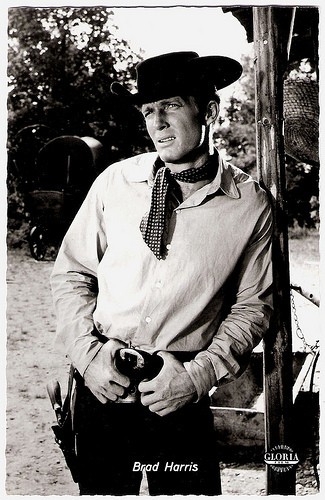
German postcard by Kolibri-Verlag, no. 2169. Photo: Rapid / Gloria / Marhoffer. Publicity still for Die Flusspiraten vom Mississippi/Pirates of the Mississippi (Jürgen Roland, 1963).
Muscular Peplum Hero
Brad Harris was born Bradford Harris in St. Anthony, a small town in eastern Idaho, USA in 1933. His family moved to California where he attended Burbank High School. He came from a family in the banking business and intended to make a career in the same area.
In the early 1950s, he received an athletic scholarship to UCLA where he studied economics. When he injured his knee playing football he was advised to take up weight lifting to strengthen the injury. This developed his interest in bodybuilding.
His studies may have been intended as the groundwork for a career in his family's banking business, but Harris instead drifted into the fringes of Los Angeles' movie industry, and secured employment as a stunt man.
He also played a small role in Monkey on My Back (André De Toth, 1957) starring Cameron Mitchell as a World War II hero and champion professional boxer, who became addicted to morphine. He also appeared in the western 13 Fighting Men (Harry W. Gerstad, 1960) with Grant Williams.
Harris travelled to Rome to watch the 1960 Summer Olympics and to perform stunts as a gladiator in Stanley Kubrick's Spartacus (1960) starring Kirk Douglas . He stayed in Europe and found himself working as a second-unit director for the short film Eco nel villaggio/Echo in the village (Themistocles Hoetis, 1961).
Harris was invited to join the ranks of American actors and body-builders in the Peplum genre (sword and sandal films) - following in the wake of Steve Reeves ' successful portrayal of Hercules.
Harris first starring role was as Goliath in the Peplum Goliath contro i giganti/Goliath Against the Giants (Guido Malatesta, 1961) opposite Spanish actor Fernando Rey. He then played Samson in Sansone/Samson (Gianfranco Parolini, 1961), and Hercules in La furia di Ercole/The Fury of Hercules (Gianfranco Parolini, 1962), both with bodybuilder Sergio Ciani a.k.a. Alan Steel and French musician Serge Gainsbourg .
His good looks and muscular build kept Harris in demand. Of the muscular Peplum heroes, Brad Harris was the first to branch out into other film genres. When the Peplum genre began to fade away, he moved into a spate of action films.
In Germany he appeared in Heißer Hafen Hong Kong/Hong Kong Hot Harbor (Jürgen Roland, 1962) with Marianne Koch , and Weiße Fracht für Hongkong/Operation Hong Kong (Helmut Ashley, Giorgio Stegani, 1964) featuring Maria Perschy .
Harris discovered that stunt coordinators were nonexistent in Germany and he often did extra duties as a stuntman, stunt coordinator, and second unit director. During the shooting of Das Geheimnis der chinesischen Nelke/Secret of the Chinese Carnation (Rudolf Zehetgruber, 1964), he fell in love with his co-star, Czech actress Olga Schoberová. They married in 1967, but divorced two years later.
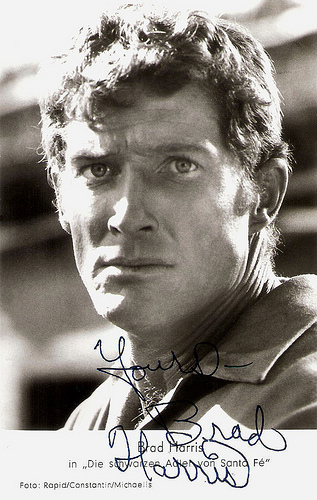
German card. Photo: Rapid / Constantin / Michaelis. Publicity still for Die Schwarzen Adler von Santa Fé/Black Eagle of Santa Fe (Ernst Hofbauer, 1965).
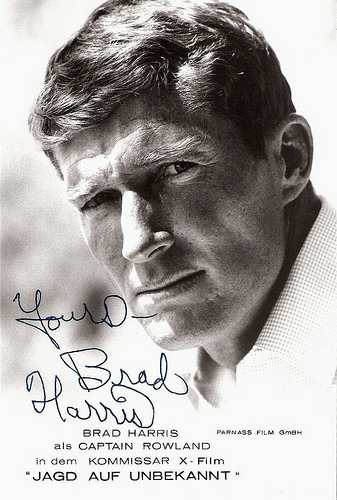
German card. Photo: Parnass Film GmBH. Publicity still for Kommissar X - Jagd auf Unbekannt/Kiss Kiss, Kill Kill (Gianfranco Parolini, 1966).
Kommissar X
In 1963, Brad Harris co-starred with Hansjörg Felmy in the early Euro-Western Die Flusspiraten vom Mississippi/Pirates of the Mississippi (Jürgen Roland, 1963).
It lead to more parts in Westerns like the West-German-Italian-French co-production Die Goldsucher von Arkansas/Massacre at Marble City (Paul Martin, 1964) with Mario Adorf , another West-German-Italian-French co-production Die schwarzen Adler von Santa Fe/Black Eagle of Santa Fe (Ernst Hofbauer, 1965) with Tony Kendall, the Spanish-Italian Un hombre vino a matar/Rattler Kid (León Klimovsky, 1967) and the Italian Wanted Sabata (Roberto Mauri, 1970).
Another popular European genre in which he often starred was the Euro-spy-thriller. Examples are A 001, operazione Giamaica/Our Man in Jamaica (Ernst R. von Theumer, Mel Welles, 1965) starring Larry Pennell and Barbara Valentin , and the Kommissar X film series (1966-1971), six films featuring Tony Kendall.
By 1970, Harris was writing and producing films and headed his own production company, Three Star Films, including distribution and foreign sales in Rome, Italy. In addition, he acted as creative consultant for various German film companies.
He also continued to work in genre films like the Giallo La casa della paura/The Girl in 2A (William Rose, 1974) with Raf Vallone , and the horror comedy Lady Dracula (Franz Josef Gottlieb, 1978), for which he had also written the story.
He also served as executive producer on several of his films such as the Sci-fi horror The Mutations (Jack Cardiff, 1974) starring Donald Pleasence. In the following decades he guest starred in popular series as the German Krimi series Derrick (1979) and the American soap operas Dallas (1984-1989) and Falcon Crest (1984-1989).
He also appeared in a new version of Hercules (Luigi Cozzi, 1983), now starring TV Hulk Lou Ferrigno. At the 4th Golden Raspberry Awards, Hercules was nominated for five awards: worst screenplay, worst supporting actress (Sybil Danning), worst actor (Lou Ferrigno), worst new star (Ferrigno), and worst picture. It won Raspberries for worst supporting actress and worst new star.
Since then Harris only incidentally returned for the cameras. He invented an exercise machine called AB-OrigOnals, and owns a fitness products company called Modern Body Design. At the Muscle Beach Bodybuilding Championship in 2001, Harris received a special achievement award along with other ‘Legends of Hercules’ - Mark Forest, Ed Fury, Mickey Hargitay, Richard Harrison, Reg Lewis, Peter Lupus and Gordon Mitchell.
In 2012, he returned to the screen in the American thriller Shiver (Julian Richards, 2012) starring Caspar van Dien, for which he also served as executive producer, and in the German comedy Die X-Männer schlagen zurück/The X-Men Strike Back (Reginald Ginster, 2012), for which he was reunited with Tony Kendall.
Brad Harris passed away on 7 November 2017 at the age of 84. Harris was a member of the Stuntman's Hall of Fame. He and his ex-wife Olga Schoberová had a daughter, Sabrina (Babrinka) Harris.
Trailer for A 001, operazione Giamaica/Our Man in Jamaica (1965). Source: Dolorado Films (YouTube).
Trailer Hercules (1983). Source: Old Hollywood Trailers (YouTube).
Sources: Bruce Eder (AllMovie), Brian J. Walker (Brian’s Drive-In Theater), Wikipedia and .

German postcard by Kolibri-Verlag, no. 2169. Photo: Rapid / Gloria / Marhoffer. Publicity still for Die Flusspiraten vom Mississippi/Pirates of the Mississippi (Jürgen Roland, 1963).
Muscular Peplum Hero
Brad Harris was born Bradford Harris in St. Anthony, a small town in eastern Idaho, USA in 1933. His family moved to California where he attended Burbank High School. He came from a family in the banking business and intended to make a career in the same area.
In the early 1950s, he received an athletic scholarship to UCLA where he studied economics. When he injured his knee playing football he was advised to take up weight lifting to strengthen the injury. This developed his interest in bodybuilding.
His studies may have been intended as the groundwork for a career in his family's banking business, but Harris instead drifted into the fringes of Los Angeles' movie industry, and secured employment as a stunt man.
He also played a small role in Monkey on My Back (André De Toth, 1957) starring Cameron Mitchell as a World War II hero and champion professional boxer, who became addicted to morphine. He also appeared in the western 13 Fighting Men (Harry W. Gerstad, 1960) with Grant Williams.
Harris travelled to Rome to watch the 1960 Summer Olympics and to perform stunts as a gladiator in Stanley Kubrick's Spartacus (1960) starring Kirk Douglas . He stayed in Europe and found himself working as a second-unit director for the short film Eco nel villaggio/Echo in the village (Themistocles Hoetis, 1961).
Harris was invited to join the ranks of American actors and body-builders in the Peplum genre (sword and sandal films) - following in the wake of Steve Reeves ' successful portrayal of Hercules.
Harris first starring role was as Goliath in the Peplum Goliath contro i giganti/Goliath Against the Giants (Guido Malatesta, 1961) opposite Spanish actor Fernando Rey. He then played Samson in Sansone/Samson (Gianfranco Parolini, 1961), and Hercules in La furia di Ercole/The Fury of Hercules (Gianfranco Parolini, 1962), both with bodybuilder Sergio Ciani a.k.a. Alan Steel and French musician Serge Gainsbourg .
His good looks and muscular build kept Harris in demand. Of the muscular Peplum heroes, Brad Harris was the first to branch out into other film genres. When the Peplum genre began to fade away, he moved into a spate of action films.
In Germany he appeared in Heißer Hafen Hong Kong/Hong Kong Hot Harbor (Jürgen Roland, 1962) with Marianne Koch , and Weiße Fracht für Hongkong/Operation Hong Kong (Helmut Ashley, Giorgio Stegani, 1964) featuring Maria Perschy .
Harris discovered that stunt coordinators were nonexistent in Germany and he often did extra duties as a stuntman, stunt coordinator, and second unit director. During the shooting of Das Geheimnis der chinesischen Nelke/Secret of the Chinese Carnation (Rudolf Zehetgruber, 1964), he fell in love with his co-star, Czech actress Olga Schoberová. They married in 1967, but divorced two years later.

German card. Photo: Rapid / Constantin / Michaelis. Publicity still for Die Schwarzen Adler von Santa Fé/Black Eagle of Santa Fe (Ernst Hofbauer, 1965).

German card. Photo: Parnass Film GmBH. Publicity still for Kommissar X - Jagd auf Unbekannt/Kiss Kiss, Kill Kill (Gianfranco Parolini, 1966).
Kommissar X
In 1963, Brad Harris co-starred with Hansjörg Felmy in the early Euro-Western Die Flusspiraten vom Mississippi/Pirates of the Mississippi (Jürgen Roland, 1963).
It lead to more parts in Westerns like the West-German-Italian-French co-production Die Goldsucher von Arkansas/Massacre at Marble City (Paul Martin, 1964) with Mario Adorf , another West-German-Italian-French co-production Die schwarzen Adler von Santa Fe/Black Eagle of Santa Fe (Ernst Hofbauer, 1965) with Tony Kendall, the Spanish-Italian Un hombre vino a matar/Rattler Kid (León Klimovsky, 1967) and the Italian Wanted Sabata (Roberto Mauri, 1970).
Another popular European genre in which he often starred was the Euro-spy-thriller. Examples are A 001, operazione Giamaica/Our Man in Jamaica (Ernst R. von Theumer, Mel Welles, 1965) starring Larry Pennell and Barbara Valentin , and the Kommissar X film series (1966-1971), six films featuring Tony Kendall.
By 1970, Harris was writing and producing films and headed his own production company, Three Star Films, including distribution and foreign sales in Rome, Italy. In addition, he acted as creative consultant for various German film companies.
He also continued to work in genre films like the Giallo La casa della paura/The Girl in 2A (William Rose, 1974) with Raf Vallone , and the horror comedy Lady Dracula (Franz Josef Gottlieb, 1978), for which he had also written the story.
He also served as executive producer on several of his films such as the Sci-fi horror The Mutations (Jack Cardiff, 1974) starring Donald Pleasence. In the following decades he guest starred in popular series as the German Krimi series Derrick (1979) and the American soap operas Dallas (1984-1989) and Falcon Crest (1984-1989).
He also appeared in a new version of Hercules (Luigi Cozzi, 1983), now starring TV Hulk Lou Ferrigno. At the 4th Golden Raspberry Awards, Hercules was nominated for five awards: worst screenplay, worst supporting actress (Sybil Danning), worst actor (Lou Ferrigno), worst new star (Ferrigno), and worst picture. It won Raspberries for worst supporting actress and worst new star.
Since then Harris only incidentally returned for the cameras. He invented an exercise machine called AB-OrigOnals, and owns a fitness products company called Modern Body Design. At the Muscle Beach Bodybuilding Championship in 2001, Harris received a special achievement award along with other ‘Legends of Hercules’ - Mark Forest, Ed Fury, Mickey Hargitay, Richard Harrison, Reg Lewis, Peter Lupus and Gordon Mitchell.
In 2012, he returned to the screen in the American thriller Shiver (Julian Richards, 2012) starring Caspar van Dien, for which he also served as executive producer, and in the German comedy Die X-Männer schlagen zurück/The X-Men Strike Back (Reginald Ginster, 2012), for which he was reunited with Tony Kendall.
Brad Harris passed away on 7 November 2017 at the age of 84. Harris was a member of the Stuntman's Hall of Fame. He and his ex-wife Olga Schoberová had a daughter, Sabrina (Babrinka) Harris.
Trailer for A 001, operazione Giamaica/Our Man in Jamaica (1965). Source: Dolorado Films (YouTube).
Trailer Hercules (1983). Source: Old Hollywood Trailers (YouTube).
Sources: Bruce Eder (AllMovie), Brian J. Walker (Brian’s Drive-In Theater), Wikipedia and .
Published on November 08, 2017 22:00
Brad Harris (1933-2017
On 7 November 2017, American stuntman and actor Brad Harris passed away. During the 1960s and 1970s, he was one of the muscular action heroes of the European cinema and he played in about 50 Peplums, Eurospy films and Spaghetti Westerns. Harris was 84.

German postcard by Kolibri-Verlag, no. 2169. Photo: Rapid / Gloria / Marhoffer. Publicity still for Die Flusspiraten vom Mississippi/Pirates of the Mississippi (Jürgen Roland, 1963).
Muscular Peplum Hero
Brad Harris was born Bradford Harris in St. Anthony, a small town in eastern Idaho, USA in 1933. His family moved to California where he attended Burbank High School. He came from a family in the banking business and intended to make a career in the same area.
In the early 1950s, he received an athletic scholarship to UCLA where he studied economics. When he injured his knee playing football he was advised to take up weight lifting to strengthen the injury. This developed his interest in bodybuilding.
His studies may have been intended as the groundwork for a career in his family's banking business, but Harris instead drifted into the fringes of Los Angeles' movie industry, and secured employment as a stunt man.
He also played a small role in Monkey on My Back (André De Toth, 1957) starring Cameron Mitchell as a World War II hero and champion professional boxer, who became addicted to morphine. He also appeared in the western 13 Fighting Men (Harry W. Gerstad, 1960) with Grant Williams.
Harris travelled to Rome to watch the 1960 Summer Olympics and to perform stunts as a gladiator in Stanley Kubrick's Spartacus (1960) starring Kirk Douglas . He stayed in Europe and found himself working as a second-unit director for the short film Eco nel villaggio/Echo in the village (Themistocles Hoetis, 1961).
Harris was invited to join the ranks of American actors and body-builders in the Peplum genre (sword and sandal films) - following in the wake of Steve Reeves ' successful portrayal of Hercules.
Harris first starring role was as Goliath in the Peplum Goliath contro i giganti/Goliath Against the Giants (Guido Malatesta, 1961) opposite Spanish actor Fernando Rey. He then played Samson in Sansone/Samson (Gianfranco Parolini, 1961), and Hercules in La furia di Ercole/The Fury of Hercules (Gianfranco Parolini, 1962), both with bodybuilder Sergio Ciani a.k.a. Alan Steel and French musician Serge Gainsbourg .
His good looks and muscular build kept Harris in demand. Of the muscular Peplum heroes, Brad Harris was the first to branch out into other film genres. When the Peplum genre began to fade away, he moved into a spate of action films.
In Germany he appeared in Heißer Hafen Hong Kong/Hong Kong Hot Harbor (Jürgen Roland, 1962) with Marianne Koch , and Weiße Fracht für Hongkong/Operation Hong Kong (Helmut Ashley, Giorgio Stegani, 1964) featuring Maria Perschy .
Harris discovered that stunt coordinators were nonexistent in Germany and he often did extra duties as a stuntman, stunt coordinator, and second unit director. During the shooting of Das Geheimnis der chinesischen Nelke/Secret of the Chinese Carnation (Rudolf Zehetgruber, 1964), he fell in love with his co-star, Czech actress Olga Schoberová. They married in 1967, but divorced two years later.

German card. Photo: Rapid / Constantin / Michaelis. Publicity still for Die Schwarzen Adler von Santa Fé/Black Eagle of Santa Fe (Ernst Hofbauer, 1965).

German card. Photo: Parnass Film GmBH. Publicity still for Kommissar X - Jagd auf Unbekannt/Kiss Kiss, Kill Kill (Gianfranco Parolini, 1966).
Kommissar X
In 1963, Brad Harris co-starred with Hansjörg Felmy in the early Euro-Western Die Flusspiraten vom Mississippi/Pirates of the Mississippi (Jürgen Roland, 1963).
It lead to more parts in Westerns like the West-German-Italian-French co-production Die Goldsucher von Arkansas/Massacre at Marble City (Paul Martin, 1964) with Mario Adorf , another West-German-Italian-French co-production Die schwarzen Adler von Santa Fe/Black Eagle of Santa Fe (Ernst Hofbauer, 1965) with Tony Kendall, the Spanish-Italian Un hombre vino a matar/Rattler Kid (León Klimovsky, 1967) and the Italian Wanted Sabata (Roberto Mauri, 1970).
Another popular European genre in which he often starred was the Euro-spy-thriller. Examples are A 001, operazione Giamaica/Our Man in Jamaica (Ernst R. von Theumer, Mel Welles, 1965) starring Larry Pennell and Barbara Valentin , and the Kommissar X film series (1966-1971), six films featuring Tony Kendall.
By 1970, Harris was writing and producing films and headed his own production company, Three Star Films, including distribution and foreign sales in Rome, Italy. In addition, he acted as creative consultant for various German film companies.
He also continued to work in genre films like the Giallo La casa della paura/The Girl in 2A (William Rose, 1974) with Raf Vallone , and the horror comedy Lady Dracula (Franz Josef Gottlieb, 1978), for which he had also written the story.
He also served as executive producer on several of his films such as the Sci-fi horror The Mutations (Jack Cardiff, 1974) starring Donald Pleasence. In the following decades he guest starred in popular series as the German Krimi series Derrick (1979) and the American soap operas Dallas (1984-1989) and Falcon Crest (1984-1989).
He also appeared in a new version of Hercules (Luigi Cozzi, 1983), now starring TV Hulk Lou Ferrigno. At the 4th Golden Raspberry Awards, Hercules was nominated for five awards: worst screenplay, worst supporting actress (Sybil Danning), worst actor (Lou Ferrigno), worst new star (Ferrigno), and worst picture. It won Raspberries for worst supporting actress and worst new star.
Since then Harris only incidentally returned for the cameras. He invented an exercise machine called AB-OrigOnals, and owns a fitness products company called Modern Body Design. At the Muscle Beach Bodybuilding Championship in 2001, Harris received a special achievement award along with other ‘Legends of Hercules’ - Mark Forest, Ed Fury, Mickey Hargitay, Richard Harrison, Reg Lewis, Peter Lupus and Gordon Mitchell.
In 2012, he returned to the screen in the American thriller Shiver (Julian Richards, 2012) starring Caspar van Dien, for which he also served as executive producer, and in the German comedy Die X-Männer schlagen zurück/The X-Men Strike Back (Reginald Ginster, 2012), for which he was reunited with Tony Kendall.
Brad Harris passed away on 7 November 2017 at the age of 84. Harris was a member of the Stuntman's Hall of Fame. He and his ex-wife Olga Schoberová had a daughter, Sabrina (Babrinka) Harris.
Trailer for A 001, operazione Giamaica/Our Man in Jamaica (1965). Source: Dolorado Films (YouTube).
Trailer Hercules (1983). Source: Old Hollywood Trailers (YouTube).
Sources: Bruce Eder (AllMovie), Brian J. Walker (Brian’s Drive-In Theater), Wikipedia and .

German postcard by Kolibri-Verlag, no. 2169. Photo: Rapid / Gloria / Marhoffer. Publicity still for Die Flusspiraten vom Mississippi/Pirates of the Mississippi (Jürgen Roland, 1963).
Muscular Peplum Hero
Brad Harris was born Bradford Harris in St. Anthony, a small town in eastern Idaho, USA in 1933. His family moved to California where he attended Burbank High School. He came from a family in the banking business and intended to make a career in the same area.
In the early 1950s, he received an athletic scholarship to UCLA where he studied economics. When he injured his knee playing football he was advised to take up weight lifting to strengthen the injury. This developed his interest in bodybuilding.
His studies may have been intended as the groundwork for a career in his family's banking business, but Harris instead drifted into the fringes of Los Angeles' movie industry, and secured employment as a stunt man.
He also played a small role in Monkey on My Back (André De Toth, 1957) starring Cameron Mitchell as a World War II hero and champion professional boxer, who became addicted to morphine. He also appeared in the western 13 Fighting Men (Harry W. Gerstad, 1960) with Grant Williams.
Harris travelled to Rome to watch the 1960 Summer Olympics and to perform stunts as a gladiator in Stanley Kubrick's Spartacus (1960) starring Kirk Douglas . He stayed in Europe and found himself working as a second-unit director for the short film Eco nel villaggio/Echo in the village (Themistocles Hoetis, 1961).
Harris was invited to join the ranks of American actors and body-builders in the Peplum genre (sword and sandal films) - following in the wake of Steve Reeves ' successful portrayal of Hercules.
Harris first starring role was as Goliath in the Peplum Goliath contro i giganti/Goliath Against the Giants (Guido Malatesta, 1961) opposite Spanish actor Fernando Rey. He then played Samson in Sansone/Samson (Gianfranco Parolini, 1961), and Hercules in La furia di Ercole/The Fury of Hercules (Gianfranco Parolini, 1962), both with bodybuilder Sergio Ciani a.k.a. Alan Steel and French musician Serge Gainsbourg .
His good looks and muscular build kept Harris in demand. Of the muscular Peplum heroes, Brad Harris was the first to branch out into other film genres. When the Peplum genre began to fade away, he moved into a spate of action films.
In Germany he appeared in Heißer Hafen Hong Kong/Hong Kong Hot Harbor (Jürgen Roland, 1962) with Marianne Koch , and Weiße Fracht für Hongkong/Operation Hong Kong (Helmut Ashley, Giorgio Stegani, 1964) featuring Maria Perschy .
Harris discovered that stunt coordinators were nonexistent in Germany and he often did extra duties as a stuntman, stunt coordinator, and second unit director. During the shooting of Das Geheimnis der chinesischen Nelke/Secret of the Chinese Carnation (Rudolf Zehetgruber, 1964), he fell in love with his co-star, Czech actress Olga Schoberová. They married in 1967, but divorced two years later.

German card. Photo: Rapid / Constantin / Michaelis. Publicity still for Die Schwarzen Adler von Santa Fé/Black Eagle of Santa Fe (Ernst Hofbauer, 1965).

German card. Photo: Parnass Film GmBH. Publicity still for Kommissar X - Jagd auf Unbekannt/Kiss Kiss, Kill Kill (Gianfranco Parolini, 1966).
Kommissar X
In 1963, Brad Harris co-starred with Hansjörg Felmy in the early Euro-Western Die Flusspiraten vom Mississippi/Pirates of the Mississippi (Jürgen Roland, 1963).
It lead to more parts in Westerns like the West-German-Italian-French co-production Die Goldsucher von Arkansas/Massacre at Marble City (Paul Martin, 1964) with Mario Adorf , another West-German-Italian-French co-production Die schwarzen Adler von Santa Fe/Black Eagle of Santa Fe (Ernst Hofbauer, 1965) with Tony Kendall, the Spanish-Italian Un hombre vino a matar/Rattler Kid (León Klimovsky, 1967) and the Italian Wanted Sabata (Roberto Mauri, 1970).
Another popular European genre in which he often starred was the Euro-spy-thriller. Examples are A 001, operazione Giamaica/Our Man in Jamaica (Ernst R. von Theumer, Mel Welles, 1965) starring Larry Pennell and Barbara Valentin , and the Kommissar X film series (1966-1971), six films featuring Tony Kendall.
By 1970, Harris was writing and producing films and headed his own production company, Three Star Films, including distribution and foreign sales in Rome, Italy. In addition, he acted as creative consultant for various German film companies.
He also continued to work in genre films like the Giallo La casa della paura/The Girl in 2A (William Rose, 1974) with Raf Vallone , and the horror comedy Lady Dracula (Franz Josef Gottlieb, 1978), for which he had also written the story.
He also served as executive producer on several of his films such as the Sci-fi horror The Mutations (Jack Cardiff, 1974) starring Donald Pleasence. In the following decades he guest starred in popular series as the German Krimi series Derrick (1979) and the American soap operas Dallas (1984-1989) and Falcon Crest (1984-1989).
He also appeared in a new version of Hercules (Luigi Cozzi, 1983), now starring TV Hulk Lou Ferrigno. At the 4th Golden Raspberry Awards, Hercules was nominated for five awards: worst screenplay, worst supporting actress (Sybil Danning), worst actor (Lou Ferrigno), worst new star (Ferrigno), and worst picture. It won Raspberries for worst supporting actress and worst new star.
Since then Harris only incidentally returned for the cameras. He invented an exercise machine called AB-OrigOnals, and owns a fitness products company called Modern Body Design. At the Muscle Beach Bodybuilding Championship in 2001, Harris received a special achievement award along with other ‘Legends of Hercules’ - Mark Forest, Ed Fury, Mickey Hargitay, Richard Harrison, Reg Lewis, Peter Lupus and Gordon Mitchell.
In 2012, he returned to the screen in the American thriller Shiver (Julian Richards, 2012) starring Caspar van Dien, for which he also served as executive producer, and in the German comedy Die X-Männer schlagen zurück/The X-Men Strike Back (Reginald Ginster, 2012), for which he was reunited with Tony Kendall.
Brad Harris passed away on 7 November 2017 at the age of 84. Harris was a member of the Stuntman's Hall of Fame. He and his ex-wife Olga Schoberová had a daughter, Sabrina (Babrinka) Harris.
Trailer for A 001, operazione Giamaica/Our Man in Jamaica (1965). Source: Dolorado Films (YouTube).
Trailer Hercules (1983). Source: Old Hollywood Trailers (YouTube).
Sources: Bruce Eder (AllMovie), Brian J. Walker (Brian’s Drive-In Theater), Wikipedia and .
Published on November 08, 2017 22:00
November 7, 2017
Anny Duperey
French actress Anny Duperey (1947) is known for her stage, film and television roles, but she is also a best-selling author. Duperey is a Chevalier of the Légion d'honneur.
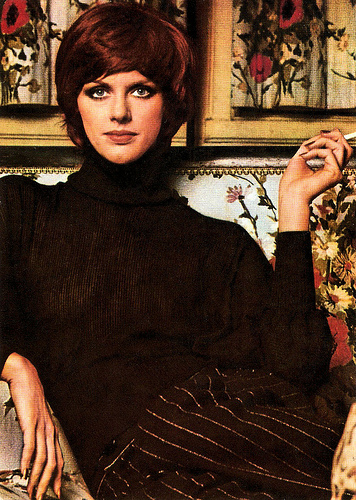
Romanian postcard by Casa Filmului Acin, no. 559.
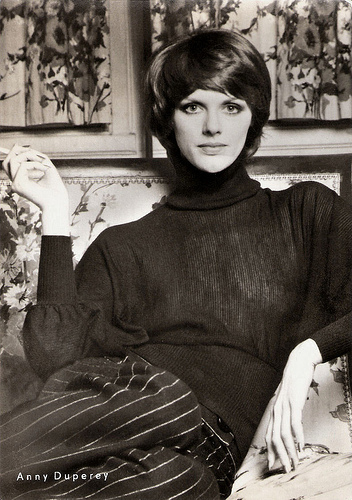
East-German postcard by VEB Progress Film-Verleih, Berlin, no. 7/78.
A red dress blown up over her head
Anny Duperey was born Annie Legras in 1947 in Rouen, Seine-Maritime, France.
Duperey made her screen debut in the both socially and stylistically radical Godard film 2 ou 3 choses que je sais d'elle/Two or Three Things I Know About Her (Jean-Luc Godard film, 1967) with Marina Vlady . The film does not tell a story so much as present an essay-like study of Godard's view of contemporary life.
In Stavisky (Alain Resnais, 1974), she portrayed Arlette, the beautiful real-life wife of flamboyant financier and embezzler Alexandre Stavisky ( Jean-Paul Belmondo ) and the circumstances leading to his mysterious death in 1934.
Anny Duperey was nominated for the 1977 César Award for Best Actress in a Supporting Role for her performance in the hilarious comedy Un éléphant ça trompe énormément/Pardon Mon Affaire (Yves Robert, 1976) with Jean Rochefort as the middle-aged, happily married businessman. One day he sees a mysterious woman (Duperey) whose flimsy red dress is blown up over her head under an air vent. This image will not leave him and he becomes obsessed with her.
The film was also nominated for the Golden Globe for Best Foreign Film and was later remade in Hollywood as The Woman in Red (Gene Wilder, 1984) with Gene Wilder and Kelly LeBrock.
Hollywood also showed interest in Duperey. She appeared with Al Pacino in the American film Bobby Deerfield (Sydney Pollack, 1977). The film is about a famous American Formula One auto racer (Pacino) who falls in love with an enigmatic Swiss woman ( Marthe Keller ) who is terminally ill. Duperey played a racetrack groupie.
That year she also debuted on Broadway. In Italy, she appeared with George Hamilton and George Peppard in the ‘Macaroni-War film’ Contro 4 bandiere/From Hell to Victory (Umberto Lenzi, 1979). In Germany, she appeared in the comedy Car-napping (Wigbert Wicker, 1980) about international car thieves. She played a supporting part in the French thriller Mille milliards de dollars/A Thousand Billion Dollars (Henri Verneuil, 1982) starring Patrick Dewaere and Michel Auclair .
Duperey co-starred with Gérard Depardieu and Pierre Richard in the hit comedy Les Compères/ComDads (Francis Veber, 1983). When her teen-aged son runs away and the police are noncommittal, Duperey convinces two old flames - a crusading journalist (Depardieu) and a hypochondriac (Richard) - that each is the father of her son in order to spur someone into action. The film was remade in the USA as Fathers' Day (Ivan Reitman, 1997) with Robin Williams, Billy Christal and Nastassja Kinski .
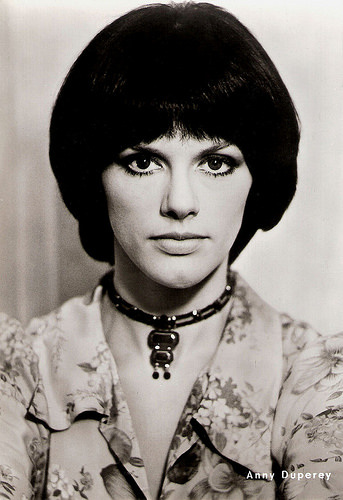
East-German postcard by VEB Progress Film-Verleih, Berlin, no. 7/78. Photo: Linke.
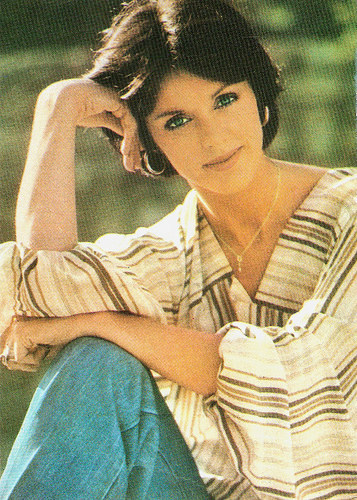
Romanian postcard by Casa Filmului Acin.
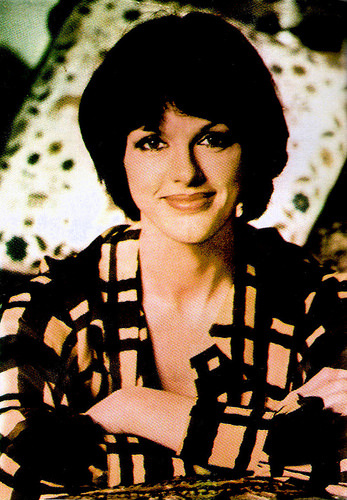
Romanian postcard by Casa Filmului Acin, no. 43 139.
You Ain't Seen Nothin' Yet!
From the mid-1980s on, Anny Duperey worked mainly for television. For the TV Mini-Series Un château au soleil/A Castle in the Sun (Robert Mazoyer, 1988), she won a 7 d'Or Best Actress award. Since 1992 she appears in the very popular French series Une famille formidable/A Magnificent Family (Joël Santoni, Alexandre Pidoux, 1992-) for which she won another 7 d'Or Best Actress award in 1993.
That year, she also could be seen in the cinema again, in the epic Germinal (Claude Berri, 1993), based on the novel by Émile Zola, and starring Gérard Depardieu and Miou-Miou. Later films include Eden à l'ouest/Eden Is West (Costa-Gavras, 2009) with Riccardo Scamarcio , and Vous n'avez encore rien vu/You Ain't Seen Nothin' Yet! (Alain Resnais, 2012) with Mathieu Amalric and Pierre Arditi.
For her stage work, Duperey won five times the Molière award, the main French stage award. Anny Duperey is also a successful author of a number of bestselling books including L'admiroir (1976), Le Nez de Mazarin (Mazarin's Nose) (1986), Le voile noir (The Black Veil) (1992), Je vous écris (I'm Writing To You) (1993), Les chats de hasard (The fortune cats) (1999), Allons plus loin, veux-tu? (Let's go further, will you?) (2002), Les chats mots (The cats words) (2003) and Une soirée (An evening) (2005).
In 2006, she led in an adaption of Oscar and the Lady in Pink (Oscar et la dame rose) (2002), a novel written by Éric-Emmanuel Schmitt; she performed at the L'Avant-Seine Theatre in Colombes. A social activist, Anny Duperey has volunteered for causes such as the international child welfare organisation SOS Children's Villages and SOS-PAPA an international organisation to help ensure children of divorce have full participation by both parents. Her work earned her an appointment as Chevalier (Knight) of Legion of Honour in 1997.
She is the mother of actress Sara Giraudeau and son Gaël Giraudeau, with former husband Bernard Giraudeau. With Giraudeau, she acted in five productions, including the crime drama Le grand pardon/Grand Pardon (Alexandre Arcady, 1982), Meurtres à domicile/Evil in the house (Marc Lobet, 1982), and the TV film La face de l'ogre/The Face of the Monster (Bernard Giraudeau, 1988).
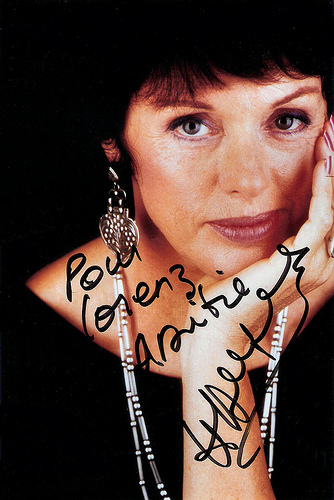
French autograph photo.
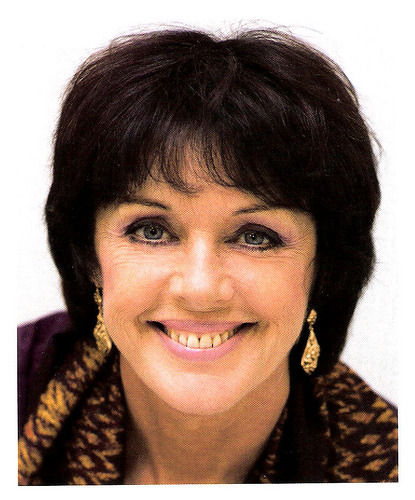
French promotion card by SOS Villages d'Enfants, no. SOS 8 001 805.
Original trailer for Stavisky (1974). Source: Film & Clips (YouTube).
The famous scene from Un Éléphant Ça Trompe Énormément (1976). Source: Ondo Tonko (YouTube).
Sources: AllMovie, Wikipedia, and .

Romanian postcard by Casa Filmului Acin, no. 559.

East-German postcard by VEB Progress Film-Verleih, Berlin, no. 7/78.
A red dress blown up over her head
Anny Duperey was born Annie Legras in 1947 in Rouen, Seine-Maritime, France.
Duperey made her screen debut in the both socially and stylistically radical Godard film 2 ou 3 choses que je sais d'elle/Two or Three Things I Know About Her (Jean-Luc Godard film, 1967) with Marina Vlady . The film does not tell a story so much as present an essay-like study of Godard's view of contemporary life.
In Stavisky (Alain Resnais, 1974), she portrayed Arlette, the beautiful real-life wife of flamboyant financier and embezzler Alexandre Stavisky ( Jean-Paul Belmondo ) and the circumstances leading to his mysterious death in 1934.
Anny Duperey was nominated for the 1977 César Award for Best Actress in a Supporting Role for her performance in the hilarious comedy Un éléphant ça trompe énormément/Pardon Mon Affaire (Yves Robert, 1976) with Jean Rochefort as the middle-aged, happily married businessman. One day he sees a mysterious woman (Duperey) whose flimsy red dress is blown up over her head under an air vent. This image will not leave him and he becomes obsessed with her.
The film was also nominated for the Golden Globe for Best Foreign Film and was later remade in Hollywood as The Woman in Red (Gene Wilder, 1984) with Gene Wilder and Kelly LeBrock.
Hollywood also showed interest in Duperey. She appeared with Al Pacino in the American film Bobby Deerfield (Sydney Pollack, 1977). The film is about a famous American Formula One auto racer (Pacino) who falls in love with an enigmatic Swiss woman ( Marthe Keller ) who is terminally ill. Duperey played a racetrack groupie.
That year she also debuted on Broadway. In Italy, she appeared with George Hamilton and George Peppard in the ‘Macaroni-War film’ Contro 4 bandiere/From Hell to Victory (Umberto Lenzi, 1979). In Germany, she appeared in the comedy Car-napping (Wigbert Wicker, 1980) about international car thieves. She played a supporting part in the French thriller Mille milliards de dollars/A Thousand Billion Dollars (Henri Verneuil, 1982) starring Patrick Dewaere and Michel Auclair .
Duperey co-starred with Gérard Depardieu and Pierre Richard in the hit comedy Les Compères/ComDads (Francis Veber, 1983). When her teen-aged son runs away and the police are noncommittal, Duperey convinces two old flames - a crusading journalist (Depardieu) and a hypochondriac (Richard) - that each is the father of her son in order to spur someone into action. The film was remade in the USA as Fathers' Day (Ivan Reitman, 1997) with Robin Williams, Billy Christal and Nastassja Kinski .

East-German postcard by VEB Progress Film-Verleih, Berlin, no. 7/78. Photo: Linke.

Romanian postcard by Casa Filmului Acin.

Romanian postcard by Casa Filmului Acin, no. 43 139.
You Ain't Seen Nothin' Yet!
From the mid-1980s on, Anny Duperey worked mainly for television. For the TV Mini-Series Un château au soleil/A Castle in the Sun (Robert Mazoyer, 1988), she won a 7 d'Or Best Actress award. Since 1992 she appears in the very popular French series Une famille formidable/A Magnificent Family (Joël Santoni, Alexandre Pidoux, 1992-) for which she won another 7 d'Or Best Actress award in 1993.
That year, she also could be seen in the cinema again, in the epic Germinal (Claude Berri, 1993), based on the novel by Émile Zola, and starring Gérard Depardieu and Miou-Miou. Later films include Eden à l'ouest/Eden Is West (Costa-Gavras, 2009) with Riccardo Scamarcio , and Vous n'avez encore rien vu/You Ain't Seen Nothin' Yet! (Alain Resnais, 2012) with Mathieu Amalric and Pierre Arditi.
For her stage work, Duperey won five times the Molière award, the main French stage award. Anny Duperey is also a successful author of a number of bestselling books including L'admiroir (1976), Le Nez de Mazarin (Mazarin's Nose) (1986), Le voile noir (The Black Veil) (1992), Je vous écris (I'm Writing To You) (1993), Les chats de hasard (The fortune cats) (1999), Allons plus loin, veux-tu? (Let's go further, will you?) (2002), Les chats mots (The cats words) (2003) and Une soirée (An evening) (2005).
In 2006, she led in an adaption of Oscar and the Lady in Pink (Oscar et la dame rose) (2002), a novel written by Éric-Emmanuel Schmitt; she performed at the L'Avant-Seine Theatre in Colombes. A social activist, Anny Duperey has volunteered for causes such as the international child welfare organisation SOS Children's Villages and SOS-PAPA an international organisation to help ensure children of divorce have full participation by both parents. Her work earned her an appointment as Chevalier (Knight) of Legion of Honour in 1997.
She is the mother of actress Sara Giraudeau and son Gaël Giraudeau, with former husband Bernard Giraudeau. With Giraudeau, she acted in five productions, including the crime drama Le grand pardon/Grand Pardon (Alexandre Arcady, 1982), Meurtres à domicile/Evil in the house (Marc Lobet, 1982), and the TV film La face de l'ogre/The Face of the Monster (Bernard Giraudeau, 1988).

French autograph photo.

French promotion card by SOS Villages d'Enfants, no. SOS 8 001 805.
Original trailer for Stavisky (1974). Source: Film & Clips (YouTube).
The famous scene from Un Éléphant Ça Trompe Énormément (1976). Source: Ondo Tonko (YouTube).
Sources: AllMovie, Wikipedia, and .
Published on November 07, 2017 22:00
November 6, 2017
Hermann Vallentin
German actor and singer Hermann Vallentin (1872-1945) appeared in many silent films of E.A. Dupont and W.F. Murnau. The takeover of the Nazis abruptly ended his film career - Vallentin was Jewish.
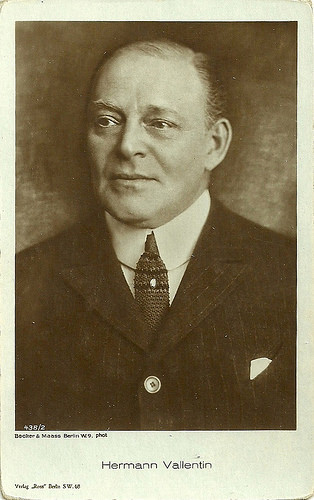
German postcard by Ross Verlag, no. 438/2. Photo: Becker & Maass, Berlin.
Very versatile as actor
Hermann Vallentin was born in 1872 in Berlin. He was the son of the wood merchant and factory owner Felix Vallentin. His sister was the actress Rosa Valetti.
After studying acting at the Königliches Schauspielhaus in Berlin from Max Grube and Hans Oberländer, Vallentin received his first engagement at the Centraltheater in Berlin in the 1895-1896 season. In the next few years, he performed at various theatres in Berlin and Wiesbaden. Between 1920 and 1932, he worked under Max Reinhardt at the Deutsches Theater.
From 1914 on, Hermann Vallentin was also a busy film actor. He was the billionaire Lloyd in the popular film Der Tunnel/The Tunnel (William Wauer, 1915), produced by the PAGU.
Vallentin was very versatile as actor and could play any kind of character. He mostly embodied family patriots, patriarchs and directors, but also small-scale philistines and - often - police commissioners.
He acted in five films by E.A. Dupont and three by F.W. Murnau. For Murnau, he appeared as the district court councillor in Schloß Vogelöd/Castle Vogeloed (1921), as Herr Binzer in Die Finanzen des Großherzogs/The Grand Duke's Finances (1924), and as a potbellied guest in Der letzte Mann/The Last Laugh (1924) with Emil Jannings .
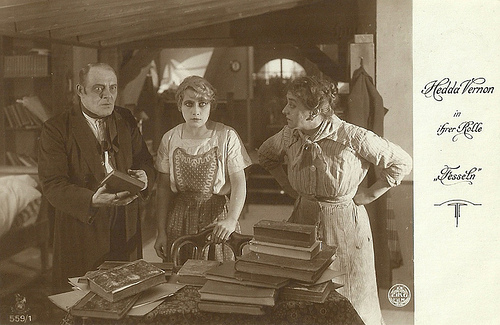
German postcard in the Film Sterne series by Rotophot, no. 559/1. Photo: Eiko-Film. Hedda Vernon and Hermann Vallentin in Fesseln/Chains (Hubert Moest, 1918).
An abrupt end of his film career
Hermann Vallentin easily moved into the sound era. In Der Hauptmann von Köpenick/The Captain from Köpenick (Richard Oswald, 1931), featuring Max Adalbert, he played the uniform tailor Adolph Wormser.
The takeover of the Nazis ended his film career abruptly - Vallentin was Jewish. In 1933 he emigrated and between 1934 and 1939 he worked on stage, subsequently in Basel, Aussig, Prague, Vienna, again Basel and Zürich.
In 1939, Hermann Vallentin emigrated to Palestine. Since he was not powerful in Hebrew, he had to cease all acting.
In Palestine, he gave lectures, recited poems, and during the Second World War, he was temporarily a presenter of German-language news for the Palestine Broadcasting Service (P.B.S.).
Just a few months after the end of the Second World War, Hermann Vallentin died in Tel Aviv in 1945. He was 73. His niece Lotte Stein also made name as an actress.
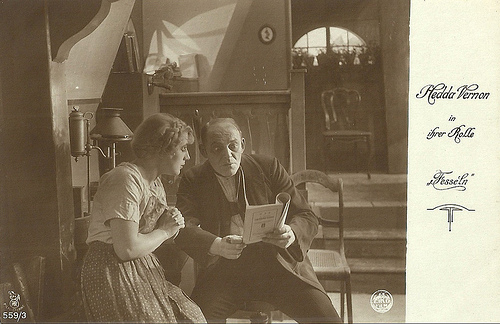
German postcard in the Film Sterne series by Rotophot, no. 559/3. Photo: Eiko-Film. Hedda Vernon and Hermann Vallentin in Fesseln/Chains (Hubert Moest, 1918).
Sources: Stephanie D'heil (Steffi-Line - German), Wikipedia (English and German) and .

German postcard by Ross Verlag, no. 438/2. Photo: Becker & Maass, Berlin.
Very versatile as actor
Hermann Vallentin was born in 1872 in Berlin. He was the son of the wood merchant and factory owner Felix Vallentin. His sister was the actress Rosa Valetti.
After studying acting at the Königliches Schauspielhaus in Berlin from Max Grube and Hans Oberländer, Vallentin received his first engagement at the Centraltheater in Berlin in the 1895-1896 season. In the next few years, he performed at various theatres in Berlin and Wiesbaden. Between 1920 and 1932, he worked under Max Reinhardt at the Deutsches Theater.
From 1914 on, Hermann Vallentin was also a busy film actor. He was the billionaire Lloyd in the popular film Der Tunnel/The Tunnel (William Wauer, 1915), produced by the PAGU.
Vallentin was very versatile as actor and could play any kind of character. He mostly embodied family patriots, patriarchs and directors, but also small-scale philistines and - often - police commissioners.
He acted in five films by E.A. Dupont and three by F.W. Murnau. For Murnau, he appeared as the district court councillor in Schloß Vogelöd/Castle Vogeloed (1921), as Herr Binzer in Die Finanzen des Großherzogs/The Grand Duke's Finances (1924), and as a potbellied guest in Der letzte Mann/The Last Laugh (1924) with Emil Jannings .

German postcard in the Film Sterne series by Rotophot, no. 559/1. Photo: Eiko-Film. Hedda Vernon and Hermann Vallentin in Fesseln/Chains (Hubert Moest, 1918).
An abrupt end of his film career
Hermann Vallentin easily moved into the sound era. In Der Hauptmann von Köpenick/The Captain from Köpenick (Richard Oswald, 1931), featuring Max Adalbert, he played the uniform tailor Adolph Wormser.
The takeover of the Nazis ended his film career abruptly - Vallentin was Jewish. In 1933 he emigrated and between 1934 and 1939 he worked on stage, subsequently in Basel, Aussig, Prague, Vienna, again Basel and Zürich.
In 1939, Hermann Vallentin emigrated to Palestine. Since he was not powerful in Hebrew, he had to cease all acting.
In Palestine, he gave lectures, recited poems, and during the Second World War, he was temporarily a presenter of German-language news for the Palestine Broadcasting Service (P.B.S.).
Just a few months after the end of the Second World War, Hermann Vallentin died in Tel Aviv in 1945. He was 73. His niece Lotte Stein also made name as an actress.

German postcard in the Film Sterne series by Rotophot, no. 559/3. Photo: Eiko-Film. Hedda Vernon and Hermann Vallentin in Fesseln/Chains (Hubert Moest, 1918).
Sources: Stephanie D'heil (Steffi-Line - German), Wikipedia (English and German) and .
Published on November 06, 2017 22:00
November 5, 2017
Henry Stuart
Henry Stuart (1885-1942) was a British-Swiss actor, director and writer, who was very successful in the German silent cinema.
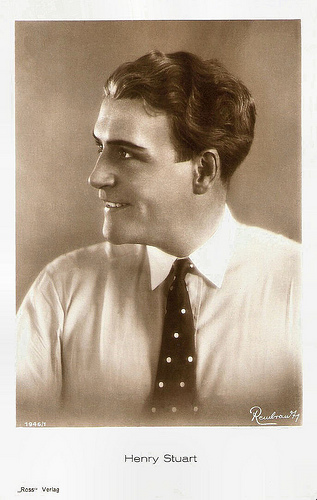
German postcard by Ross Verlag, no. 1946/1, 1927-1928. Photo: Rembrandt.
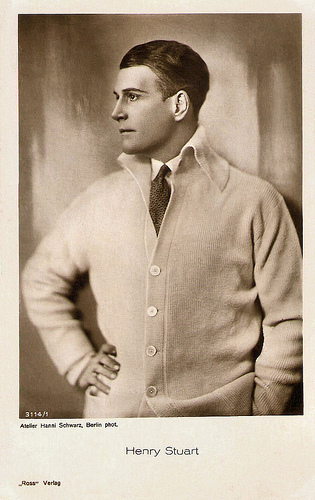
German postcard by Ross Verlag, no. 3114/1, 1928-1929. Photo: Atelier Hanni Schwarz, Berlin.
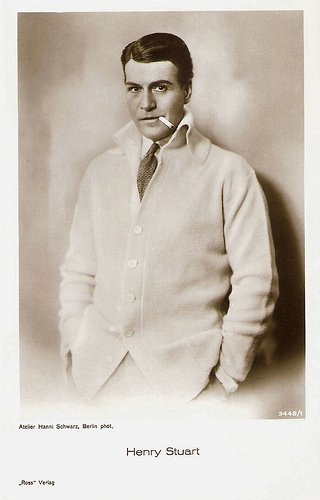
German postcard by Ross Verlag, no. 3448/1, 1928-1929. Photo: Atelier Hanni Schwarz.
Perfect Gentleman and Noble Lover
Henry Stuart was born as Henry Eduard Hess in Cairo, Egypt, in 1885. He was the son of a British colonial employee. Shortly before 1900 he returned to Britain but grew up mostly in Paris.
He visited the Akademie der Bildenden Künste München (Academy of Fine Arts in Munich), planning to become a painter. Shortly before World War One broke out, he was in Vienna, where he established his first contacts in the film world. During the war Stuart stayed in Britain, but afterwards he returned to Germany.
In 1922 he started his highly successful career as actor in the German silent cinema, often performing the perfect gentleman and noble lover. Probably his first appearance was a small part in the elaborate costume drama Ein Glas Wasser/A Glass of Water (Ludwig Berger, 1922) set in England during the reign of Queen Anne (Mady Christians). According to Wikipedia , the film was very well received both commercially and critically on its release. The film, based on a play of the same title by Eugène Scribe, is considered one of the milestones of Weimar cinema.
It was followed by the fantasy Die Perrücke/The Wig (Berthold Viertel, 1924) in which he played the major part of Julian, the lover of the Princess ( Jenny Hasselqvist ), whose husband ( Otto Gebühr ) tries to separate them.
In another classic Die freudlose Gasse/Joyless Street (G.W. Pabst, 1925), a morality tale set during the Viennese Depression, Stuart plays Egon Stirner, the secretary of an international speculator. He is arrested for the murder of a lawyer’s wife, but the culprit is the penniless Maria Lechner ( Asta Nielsen ). Maria is desperately in love with Stirner and has murdered the woman because she suspected her to be a rival. The film which also features Greta Garbo in one of her first roles, was one of the first films of the 'New Objectivity' movement.
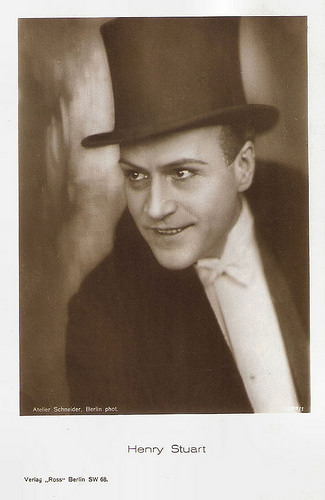
German postcard by Ross Verlag, Berlin, no. 1327/1, 1927-1928. Photo: Atelier Schneider, Berlin.
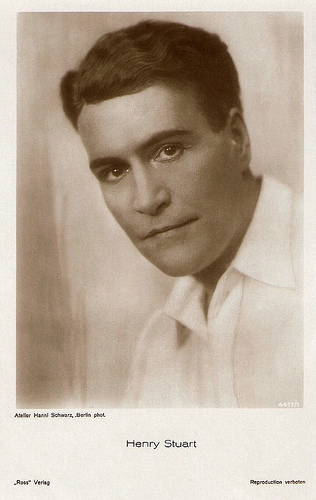
German postcard by Ross Verlag, no. 4417/1, 1929-1930. Photo: Atelier Hanni Schwarz, Berlin.
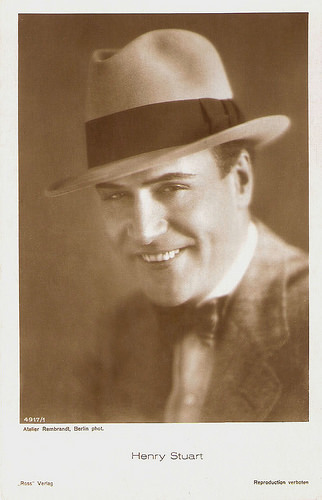
German postcard by Ross Verlag, no. 4917/1, 1929-1930. Photo: Atelier Rembrandt, Berlin.
India
In the following years Henry Suart starred in an impressive series of films. In 1925 he appeared in Die Strasse des Vergessens/The Street of Forgetting (Heinz Paul, 1925) with Hella Moja , and Das Abenteuer der Sybille Brant/The Adventures of Sybil Brent (Carl Froehlich, 1925) with Henny Porten.
The following year, he acted in such films as Unter Ausschluss der Öffentlichkeit/Under exclusion of the public (Conrad Wiene, 1926) with Maly Delschaft , Schenk mir das Leben/Give me the life (Klaus Fery, 1926), the war film Die versunkene Flotte/Wrath of the Seas (Graham Hewett, Manfred Noa, 1926) with Nils Asther , Die zwei und die Dame/The Two and the Lady (Alwin Neuss, 1926) with Agnes Esterhazy and Bernhard Goetzke , and Das Mädchen ohne Heimat/The Girl Without a Homeland (Constantin J. David, 1926).
In 1927 he appeared in Liebelei/Flirtation (Jakob & Luise Fleck, 1927) with Fred Louis Lerch and Evelyn Holt , Wenn Menschen reif zur Liebe werden/When people become ripe for love (Jakob & Luise Fleck, 1927), Die geheime Macht/Sajenko the Soviet (Erich Waschneck, 1927) with Walter Rilla , Die Frau mit dem Weltrekord/The Woman with the World Record (Erich Waschneck, 1927) with Lee Parry , and Der Bettler vom Kölner Dom/The beggar of the Cologne cathedral (Rolf Randolf, 1927) with Hanni Weisse .
He starred opposite Brigitte Helm in Der Skandal in Baden-Baden/The Scandal in Baden-Baden (Erich Waschneck, 1928). That same year, Stuart went to India to stage the feature film Der Ring der Bajadere, as well as direct the documentaries Der Maharadscha von Mysore hat Geburtstag/The Birthday of the Maharadja of Mysore (Henry Stuart, 1929) and Nuri, der Elefant/Nuri, the Elephant (Henry Stuart, 1930).
Back in Germany, Stuart played his last roles in silent films: the industrialist Erwin Voss in Das Recht auf Liebe/The right on love (Jakob & Luise Fleck, 1929), The film addresses the issue of the rights of ex-soldiers made impotent by war wounds to get married. It was made in the Weimar tradition of the Aufklärungsfilme (Enlightenment films).
He also played Kaiser Franz in the part-talkie Der Günstling von Schönbrunn/The Favourite of Schonbrunn (1929), starring Iván Petrovich and Lil Dagover . The historical film was directed by Erich Waschneck but Max Reichmann directed the sound sequences.
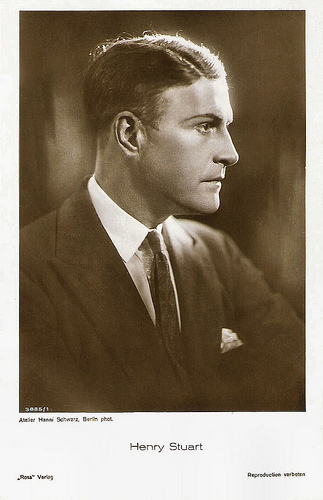
German postcard by Ross Verlag, no. 3885/1, 1928-1929. Photo: Atelier Hanni Schwarz, Berlin.
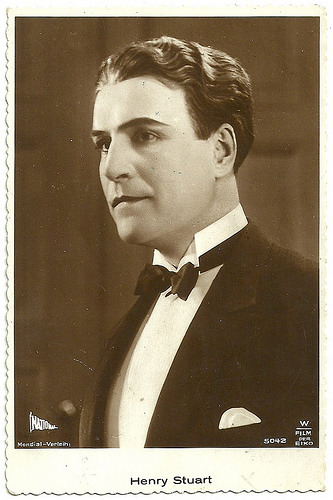
Austrian postcard, no. 5042. Photo: National / Mondial-Filmverleih / Eiko.
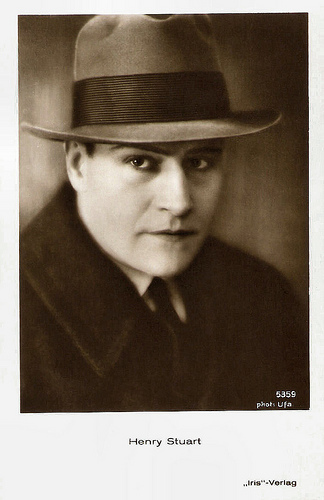
Austrian postcard by Iris Verlag, no. 5359. Photo: Ufa.
All-Star Super-Production
In the sound era, Henry Stuart didn’t find much work. In Berlin, he performed at the Englischen Theater Deutscher Schauspieler and worked for the radio as well as a manuscript and title translator. In 1933 he directed a short, Zwischen 12 und 2/Between 12 and 2, based on the play Hotelratten/Hotel rats.
In 1938 he co-wrote the script for the Yiddish-American production The Power of Life. He became Swiss citizen and in 1941 he released the only feature sound film directed by him: Krishna. Abenteuer im indischen Dschungel/Krishna, adventures in the Indian Jungle (1941), codirected and conscripted with Lola Kreuzberg, whose company had already produced Stuart’s films in India in 1928-1929. It probably was a sound version of Der Ring der Bajadere.
In 1942, Stuart played a British enemy in the propaganda film Germanin (Max W. Kimmich, 1942) starring famous Austrian mountain climber Luis Trenker as a German doctor in Africa who discovers and proves the efficacy of a cure for sleeping sickness - a serum called `Germanin'.
The film has strong anti-British undertones and the history of the film is horrendous. In the summer of 1940, 4,000 black POWs were transferred to Stalag IIIA, a Luckenwalde Germany Prisoner of War camp. Three hundred of these men, including African-Americans and French speaking Africans were forced to participate as extras in this Nazi film. Many of them were later exterminated by the Nazis.
His final film appearance was a small uncredited part, again as a British lord, in the all-star super-production Münchhausen/Baron Munchhausen (Josef von Baky, 1943) featuring Hans Albers . The Agfa colour epic was released after Stuart's death.
How, when and where exactly Henry Stuart died is unclear. His death year is indicated by several sources ( IMDb, Cyranos, Filmportal.de ) as 1942, but according to German Wikipedia it was after 1942. Another question is: did the Nazis force Stuart to appear in Germanin, like they had forced British silent film actor Jack Trevor to act in other anti-British propaganda films?
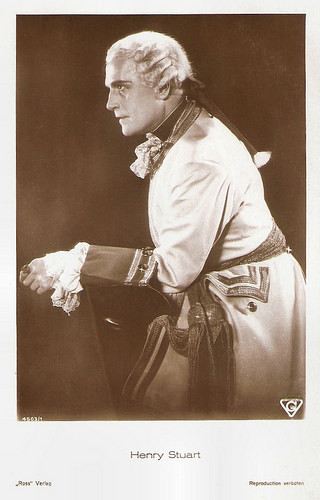
German postcard by Ross Verlag, no. 4503/1, 1929-1930. Photo: Photo: G [Greenbaum-Film]. Publicity still for Der Günstling von Schönbrunn/Favorite of Schonbrunn (Erich Waschneck, Max Reichmann, 1929).
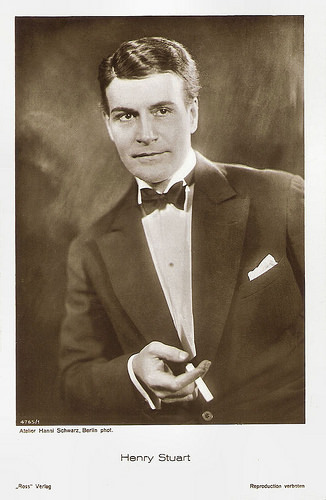
German postcard by Ross Verlag, no. 4765/1, 1929-1930. Photo: Photo: Atelier Hanni Schwarz, Berlin.
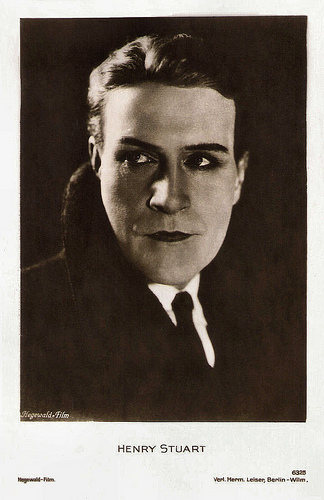
German postcard by Verlag Herm. Leiser, Berlin-Wilm., no. 6325. Photo: Hegewald-Film.
Sources: Filmportal.de, Thomas Staedeli (Cyranos), Wikipedia (English and German) and .

German postcard by Ross Verlag, no. 1946/1, 1927-1928. Photo: Rembrandt.

German postcard by Ross Verlag, no. 3114/1, 1928-1929. Photo: Atelier Hanni Schwarz, Berlin.

German postcard by Ross Verlag, no. 3448/1, 1928-1929. Photo: Atelier Hanni Schwarz.
Perfect Gentleman and Noble Lover
Henry Stuart was born as Henry Eduard Hess in Cairo, Egypt, in 1885. He was the son of a British colonial employee. Shortly before 1900 he returned to Britain but grew up mostly in Paris.
He visited the Akademie der Bildenden Künste München (Academy of Fine Arts in Munich), planning to become a painter. Shortly before World War One broke out, he was in Vienna, where he established his first contacts in the film world. During the war Stuart stayed in Britain, but afterwards he returned to Germany.
In 1922 he started his highly successful career as actor in the German silent cinema, often performing the perfect gentleman and noble lover. Probably his first appearance was a small part in the elaborate costume drama Ein Glas Wasser/A Glass of Water (Ludwig Berger, 1922) set in England during the reign of Queen Anne (Mady Christians). According to Wikipedia , the film was very well received both commercially and critically on its release. The film, based on a play of the same title by Eugène Scribe, is considered one of the milestones of Weimar cinema.
It was followed by the fantasy Die Perrücke/The Wig (Berthold Viertel, 1924) in which he played the major part of Julian, the lover of the Princess ( Jenny Hasselqvist ), whose husband ( Otto Gebühr ) tries to separate them.
In another classic Die freudlose Gasse/Joyless Street (G.W. Pabst, 1925), a morality tale set during the Viennese Depression, Stuart plays Egon Stirner, the secretary of an international speculator. He is arrested for the murder of a lawyer’s wife, but the culprit is the penniless Maria Lechner ( Asta Nielsen ). Maria is desperately in love with Stirner and has murdered the woman because she suspected her to be a rival. The film which also features Greta Garbo in one of her first roles, was one of the first films of the 'New Objectivity' movement.

German postcard by Ross Verlag, Berlin, no. 1327/1, 1927-1928. Photo: Atelier Schneider, Berlin.

German postcard by Ross Verlag, no. 4417/1, 1929-1930. Photo: Atelier Hanni Schwarz, Berlin.

German postcard by Ross Verlag, no. 4917/1, 1929-1930. Photo: Atelier Rembrandt, Berlin.
India
In the following years Henry Suart starred in an impressive series of films. In 1925 he appeared in Die Strasse des Vergessens/The Street of Forgetting (Heinz Paul, 1925) with Hella Moja , and Das Abenteuer der Sybille Brant/The Adventures of Sybil Brent (Carl Froehlich, 1925) with Henny Porten.
The following year, he acted in such films as Unter Ausschluss der Öffentlichkeit/Under exclusion of the public (Conrad Wiene, 1926) with Maly Delschaft , Schenk mir das Leben/Give me the life (Klaus Fery, 1926), the war film Die versunkene Flotte/Wrath of the Seas (Graham Hewett, Manfred Noa, 1926) with Nils Asther , Die zwei und die Dame/The Two and the Lady (Alwin Neuss, 1926) with Agnes Esterhazy and Bernhard Goetzke , and Das Mädchen ohne Heimat/The Girl Without a Homeland (Constantin J. David, 1926).
In 1927 he appeared in Liebelei/Flirtation (Jakob & Luise Fleck, 1927) with Fred Louis Lerch and Evelyn Holt , Wenn Menschen reif zur Liebe werden/When people become ripe for love (Jakob & Luise Fleck, 1927), Die geheime Macht/Sajenko the Soviet (Erich Waschneck, 1927) with Walter Rilla , Die Frau mit dem Weltrekord/The Woman with the World Record (Erich Waschneck, 1927) with Lee Parry , and Der Bettler vom Kölner Dom/The beggar of the Cologne cathedral (Rolf Randolf, 1927) with Hanni Weisse .
He starred opposite Brigitte Helm in Der Skandal in Baden-Baden/The Scandal in Baden-Baden (Erich Waschneck, 1928). That same year, Stuart went to India to stage the feature film Der Ring der Bajadere, as well as direct the documentaries Der Maharadscha von Mysore hat Geburtstag/The Birthday of the Maharadja of Mysore (Henry Stuart, 1929) and Nuri, der Elefant/Nuri, the Elephant (Henry Stuart, 1930).
Back in Germany, Stuart played his last roles in silent films: the industrialist Erwin Voss in Das Recht auf Liebe/The right on love (Jakob & Luise Fleck, 1929), The film addresses the issue of the rights of ex-soldiers made impotent by war wounds to get married. It was made in the Weimar tradition of the Aufklärungsfilme (Enlightenment films).
He also played Kaiser Franz in the part-talkie Der Günstling von Schönbrunn/The Favourite of Schonbrunn (1929), starring Iván Petrovich and Lil Dagover . The historical film was directed by Erich Waschneck but Max Reichmann directed the sound sequences.

German postcard by Ross Verlag, no. 3885/1, 1928-1929. Photo: Atelier Hanni Schwarz, Berlin.

Austrian postcard, no. 5042. Photo: National / Mondial-Filmverleih / Eiko.

Austrian postcard by Iris Verlag, no. 5359. Photo: Ufa.
All-Star Super-Production
In the sound era, Henry Stuart didn’t find much work. In Berlin, he performed at the Englischen Theater Deutscher Schauspieler and worked for the radio as well as a manuscript and title translator. In 1933 he directed a short, Zwischen 12 und 2/Between 12 and 2, based on the play Hotelratten/Hotel rats.
In 1938 he co-wrote the script for the Yiddish-American production The Power of Life. He became Swiss citizen and in 1941 he released the only feature sound film directed by him: Krishna. Abenteuer im indischen Dschungel/Krishna, adventures in the Indian Jungle (1941), codirected and conscripted with Lola Kreuzberg, whose company had already produced Stuart’s films in India in 1928-1929. It probably was a sound version of Der Ring der Bajadere.
In 1942, Stuart played a British enemy in the propaganda film Germanin (Max W. Kimmich, 1942) starring famous Austrian mountain climber Luis Trenker as a German doctor in Africa who discovers and proves the efficacy of a cure for sleeping sickness - a serum called `Germanin'.
The film has strong anti-British undertones and the history of the film is horrendous. In the summer of 1940, 4,000 black POWs were transferred to Stalag IIIA, a Luckenwalde Germany Prisoner of War camp. Three hundred of these men, including African-Americans and French speaking Africans were forced to participate as extras in this Nazi film. Many of them were later exterminated by the Nazis.
His final film appearance was a small uncredited part, again as a British lord, in the all-star super-production Münchhausen/Baron Munchhausen (Josef von Baky, 1943) featuring Hans Albers . The Agfa colour epic was released after Stuart's death.
How, when and where exactly Henry Stuart died is unclear. His death year is indicated by several sources ( IMDb, Cyranos, Filmportal.de ) as 1942, but according to German Wikipedia it was after 1942. Another question is: did the Nazis force Stuart to appear in Germanin, like they had forced British silent film actor Jack Trevor to act in other anti-British propaganda films?

German postcard by Ross Verlag, no. 4503/1, 1929-1930. Photo: Photo: G [Greenbaum-Film]. Publicity still for Der Günstling von Schönbrunn/Favorite of Schonbrunn (Erich Waschneck, Max Reichmann, 1929).

German postcard by Ross Verlag, no. 4765/1, 1929-1930. Photo: Photo: Atelier Hanni Schwarz, Berlin.

German postcard by Verlag Herm. Leiser, Berlin-Wilm., no. 6325. Photo: Hegewald-Film.
Sources: Filmportal.de, Thomas Staedeli (Cyranos), Wikipedia (English and German) and .
Published on November 05, 2017 22:00
November 4, 2017
Romuald Joubé
Today, EYE Filmmuseum in Amsterdam presents the French silent film La Chèvre aux pieds d'or/The Goat with the Golden Feet (Jacques Robert, 1925), vaguely inspired by the biography of Mata Hari. The film is shown within the framework of the new exhibition Mata Hari - The Myth and the Maiden at Fries Museum in Leeuwarden, and introduced by film historian and EFSP co-editor Ivo Blom, who collaborated on the exhibition. Male lead of the film is Romuald Joubé (1876-1949). He was a French silent film actor, who became famous for his part in Abel Gance’s J’accuse (1918). He also acted in various naturalistic features by André Antoine.
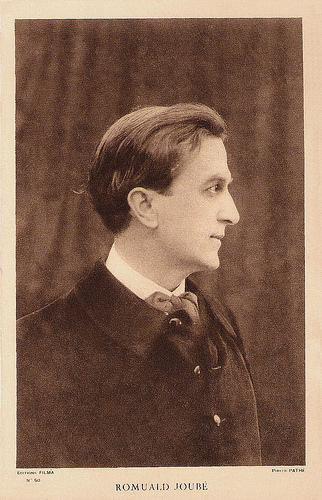
French postcard by Editions Filma, no. 50. Photo: Pathé.
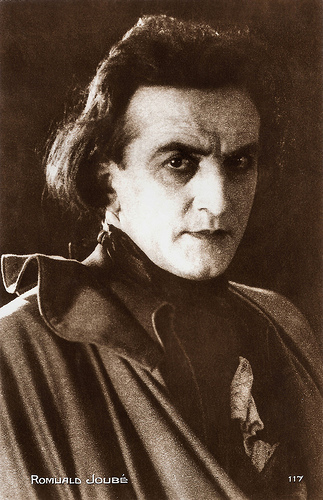
French postcard by Editions Cinémagazine, no. 117.
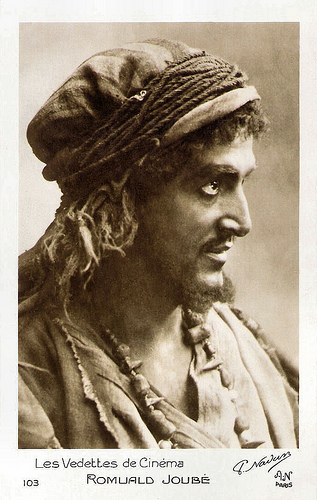
French postcard in the series Les Vedettes de Cinéma by A.N., Paris, no 103. Photo: P. Nadar.
The Horrors of the War
Romuald Joubé, originally Romuald Charles Eugène Goudens Jean Sylve Joubé was born in Mazères, France in 1876.
Around 1900, Joubé already acted on stage with the troupe of the Nouveau-Théàtre of Paris, directed by Lugné-Poë. Around 1909 he started at the Théàtre de l’Odéon with plays directed by André Antoine, the master of Naturalism in French theatre.
In 1910 he debuted in the cinema in the Film d’art productions. He played in various shorts, often directed by Henri Desfontaines. These included Polyeucte (Camille de Morlhon, 1910), Philémon et Baucis (Georges Denola, 1911) as Philemon, Milton (Henri Desfontaines, 1911) with Constant Rémy, La Mégère apprivoisée/The Taming Of The Shrew (Henri Desfontaines, 1911). He played the title roles in Le Colonel Chabert (Henri Pouctal, André Calmettes, 1911) and Brittanicus (Camille de Morlhon, 1912)
Other Film d'art films were Serge Panine (Henri Pouctal, 1913), Le Baiser supreme/The Kiss supreme (Edmond Floury, 1913) opposite Gabriel Signoret , Les Deux gosses/The Two Kids (Albert Capellani, 1914) with Paul Capellani , Amour sacré/Holy Love (Dominique Bernard-Deschamps, 1915), and Le Dernier rêve/The Last Dream (Henri Desfontaines, 1916).
In 1917, Joubé started to act in various features by André Antoine, who transferred his Naturalism onto cinema as well: the Alexandre Dumas père adaptation Les Frères corses/The Corsican Brothers (André Antoine, 1917) with Henry Krauss , the François Coppée adaptation Le Coupable/The Culprit (André Antoine, 1917) with Sylvie , and the fishermen drama Les Travailleurs de la mer/The Workers of the sea (André Antoine, 1918), based on Victor Hugo.
By now Joubé was playing both leading and supporting parts. In 1918-1919, Joubé played one of his most famous roles in the pacifist, First World War drama J’Accuse/I Accuse by Abel Gance , which was released in France in April 1919, so a few months after the Armistice.
Joubé plays Jean Diaz, a poet who is in love with Edith (Marise Dauvray), the wife of François Laurin ( Séverin-Mars ). The two men meet in the trenches and experience the horrors of the war. Laurin saves Diaz’ life and sacrifices himself for the benefit of the other two. Edith is raped by a German, raising the fruit of this encounter despite hostility. Maddened, Diaz returns from the trenches, despises his art and asks the village inhabitants: was it worthwhile, all the sacrifices, while the ghosts of the killed soldiers march up to them.
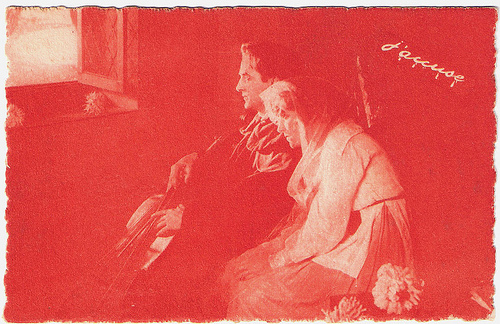
French postcard by Sadag de France, Paris, no. 109. Publicity still for J'Accuse (Abel Gance, 1919) with Edith (Marise Dauvray), Jean Diaz (Romuald Joubé).
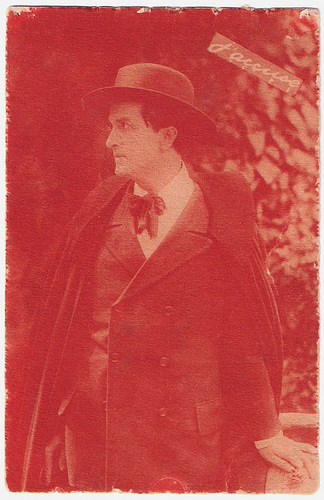
French postcard by Sadag de France, Paris. Publicity still for J'Accuse (Abel Gance, 1919).
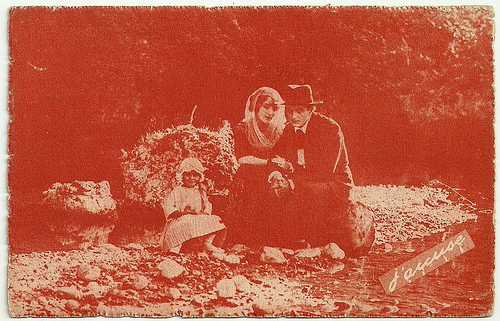
French postcard by Sadag de France, Paris, no. 109. Publicity still for J'Accuse (Abel Gance, 1919) with Edith (Marise Dauvray), Jean Diaz (Romuald Joubé) and little Angele (Angèle Guys), towards the end of the film.
Lavish Period Piece
With J’Accuse, Romuald Joubé established his career, though he didn’t continue to act with Gance. Instead he performed opposite Emmy Lynn in La faute d’Odette Marchal/Odette Marchal's fault (Henri Roussel, 1920), opposite Huguette Duflos in Mademoiselle de La Seiglière (André Antoine, 1921), opposite Sylviane Dumont in Fleur de neige/Snow Flower (Paul Barlatier, 1921) and he played the title role in the Jules Verne adaptation Mathias Sandorf (Henri Fescourt, 1921).
Subsequently he appeared opposite Pierre Fresnay in Le Diamant noir/The Black Diamond (André Hugon, 1922) and opposite Nathalie Lissenko in La Fille sauvage (Henri Étievant, 1922).
From 1923 Joubé alternated film with the stage. In the theatre he played e.g. the title role in Peer Gynt in 1924. Still he had big film roles as Andréa in Rouletabille chez les bohémiens/Rouletabille and the Bohemians (Henri Fescourt, 1923) with Gabriel de Gravone , as the title character in the historical adventure film Mandrin (Henri Fescourt, 1924) costarring Jacqueline Blanc , and as chevalier Robert Cottereau in the lavish period piece Le Miracle des loups/Miracle of the Wolves (Raymond Bernard, 1924).
In 1925 Joubé not only acted opposite Lilian Constantini in La Chèvre aux pieds d'or/The Goat with the golden feet (Jacques Robert, 1925), but he also went to Italy to act in several historical films by Giulio Antamoro: La Fanciulla di Pompei/The young girl of Pompeii (Giulio Antamoro, 1925) with Leda Gys, La Cieca di Sorrento/The Blind Girl of Sorrento (Giulio Antamoro, 1925) and Frate Francesco/The Passion of St. Francis (Giulio Antamoro, 1927).
Probably Joubé’s last silent film was the Henri Kistemaeckers adaptation Princesse Masha/Princess Masha (1927, René Leprince). The film is about an illegitimate Russian princess, raised by revolutionary intellectuals, who flees to Paris during the revolution and falls in love with a Frenchman (Joubé), but marries a cruel Russian ambassador to save her foster father (in vain). Returned to Russia during the war, she tries to flee again, with her French lover, and sacrifices herself in the end for his honour. The film starred Claudia Victrix, a French singer who debuted in this film. Costars were Jean Toulout and Andrée Brabant.
When sound cinema became the standard in France, Joubé didn’t act in films for years, though he was visible in a sonorised version of Le Miracle des loups (1930). In 1929 he acted in various stage plays in Canada, together with Germaine Rouer . In the same year he also acted in Histoires de France, the play by Sacha Guitry that opened the new Théàtre Pigalle in Paris in 1929.
In 1937 he returned to the film set with a small part as Jean Diaz in Abel Gance ’s own remake of J’accuse (Abel Gance, 1938), while the larger share of the character was played by Victor Francen. That year he also played Clouet in Sacha Guitry ’s period piece Les Perles de la couronne (Sacha Guitry, 1937).
Joubé played his last roles in film and on stage during the Second World War. On stage he played in the Georges Simenon adaptation Le Pavillon d'Asnières (1943), while on the set he performed in a.o. Chant de l'exilé/Song of Exile (André Hugo, 1943) starring Tino Rossi .
Romuald Joubé died in 1949 in Gisors, France.
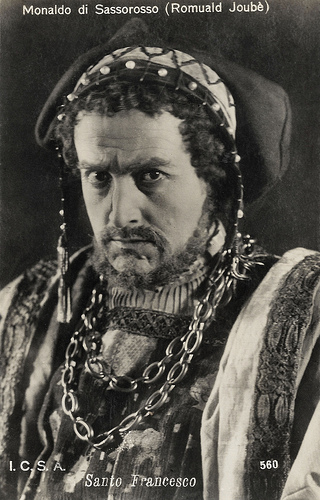
Italian postcard by ICSA, no. 560. Photo: publicity still for Frate Francesco (Giulio Antamoro, 1927) with Romuald Joubé as Monaldo di Sassorosso.
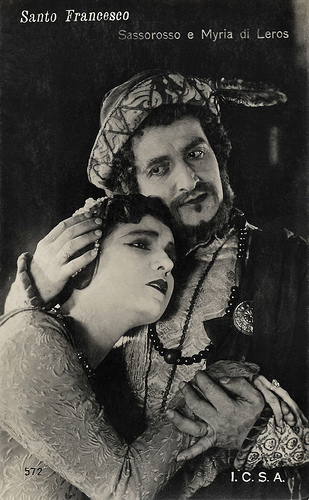
Italian postcard by ICSA, no. 572. Photo: publicity still for Frate Francesco (Giulio Antamoro, 1927) with Monaldo di Sassorosso (Romuald Joubé) and Myria di Leros (Donatella Gemmò).
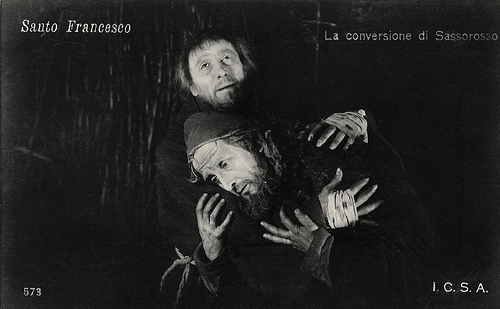
Italian postcard by ICSA, no. 573. Photo: publicity still for Frate Francesco (Giulio Antamoro, 1927). Caption: 'The conversion of Sassorosso.' Visible are Alberto Pasquali as St. Francis and Romuald Joubé as Sassorosso.
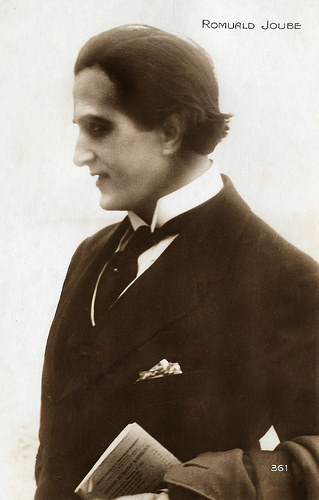
French postcard by Cinémagazine-Edition, Paris, no. 361.
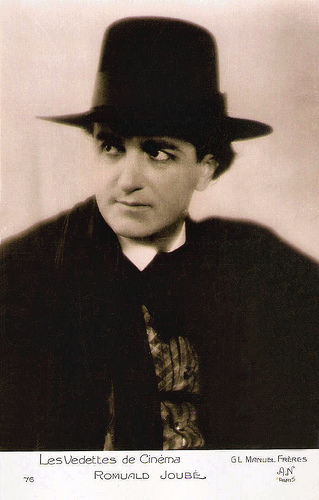
French postcard in the series Les Vedettes de Cinéma by A.N., Paris, no 76. Photo: G.L. Manuel Frères.
Sources: CinéRessources, Films de France, Wikipedia (French) and .

French postcard by Editions Filma, no. 50. Photo: Pathé.

French postcard by Editions Cinémagazine, no. 117.

French postcard in the series Les Vedettes de Cinéma by A.N., Paris, no 103. Photo: P. Nadar.
The Horrors of the War
Romuald Joubé, originally Romuald Charles Eugène Goudens Jean Sylve Joubé was born in Mazères, France in 1876.
Around 1900, Joubé already acted on stage with the troupe of the Nouveau-Théàtre of Paris, directed by Lugné-Poë. Around 1909 he started at the Théàtre de l’Odéon with plays directed by André Antoine, the master of Naturalism in French theatre.
In 1910 he debuted in the cinema in the Film d’art productions. He played in various shorts, often directed by Henri Desfontaines. These included Polyeucte (Camille de Morlhon, 1910), Philémon et Baucis (Georges Denola, 1911) as Philemon, Milton (Henri Desfontaines, 1911) with Constant Rémy, La Mégère apprivoisée/The Taming Of The Shrew (Henri Desfontaines, 1911). He played the title roles in Le Colonel Chabert (Henri Pouctal, André Calmettes, 1911) and Brittanicus (Camille de Morlhon, 1912)
Other Film d'art films were Serge Panine (Henri Pouctal, 1913), Le Baiser supreme/The Kiss supreme (Edmond Floury, 1913) opposite Gabriel Signoret , Les Deux gosses/The Two Kids (Albert Capellani, 1914) with Paul Capellani , Amour sacré/Holy Love (Dominique Bernard-Deschamps, 1915), and Le Dernier rêve/The Last Dream (Henri Desfontaines, 1916).
In 1917, Joubé started to act in various features by André Antoine, who transferred his Naturalism onto cinema as well: the Alexandre Dumas père adaptation Les Frères corses/The Corsican Brothers (André Antoine, 1917) with Henry Krauss , the François Coppée adaptation Le Coupable/The Culprit (André Antoine, 1917) with Sylvie , and the fishermen drama Les Travailleurs de la mer/The Workers of the sea (André Antoine, 1918), based on Victor Hugo.
By now Joubé was playing both leading and supporting parts. In 1918-1919, Joubé played one of his most famous roles in the pacifist, First World War drama J’Accuse/I Accuse by Abel Gance , which was released in France in April 1919, so a few months after the Armistice.
Joubé plays Jean Diaz, a poet who is in love with Edith (Marise Dauvray), the wife of François Laurin ( Séverin-Mars ). The two men meet in the trenches and experience the horrors of the war. Laurin saves Diaz’ life and sacrifices himself for the benefit of the other two. Edith is raped by a German, raising the fruit of this encounter despite hostility. Maddened, Diaz returns from the trenches, despises his art and asks the village inhabitants: was it worthwhile, all the sacrifices, while the ghosts of the killed soldiers march up to them.

French postcard by Sadag de France, Paris, no. 109. Publicity still for J'Accuse (Abel Gance, 1919) with Edith (Marise Dauvray), Jean Diaz (Romuald Joubé).

French postcard by Sadag de France, Paris. Publicity still for J'Accuse (Abel Gance, 1919).

French postcard by Sadag de France, Paris, no. 109. Publicity still for J'Accuse (Abel Gance, 1919) with Edith (Marise Dauvray), Jean Diaz (Romuald Joubé) and little Angele (Angèle Guys), towards the end of the film.
Lavish Period Piece
With J’Accuse, Romuald Joubé established his career, though he didn’t continue to act with Gance. Instead he performed opposite Emmy Lynn in La faute d’Odette Marchal/Odette Marchal's fault (Henri Roussel, 1920), opposite Huguette Duflos in Mademoiselle de La Seiglière (André Antoine, 1921), opposite Sylviane Dumont in Fleur de neige/Snow Flower (Paul Barlatier, 1921) and he played the title role in the Jules Verne adaptation Mathias Sandorf (Henri Fescourt, 1921).
Subsequently he appeared opposite Pierre Fresnay in Le Diamant noir/The Black Diamond (André Hugon, 1922) and opposite Nathalie Lissenko in La Fille sauvage (Henri Étievant, 1922).
From 1923 Joubé alternated film with the stage. In the theatre he played e.g. the title role in Peer Gynt in 1924. Still he had big film roles as Andréa in Rouletabille chez les bohémiens/Rouletabille and the Bohemians (Henri Fescourt, 1923) with Gabriel de Gravone , as the title character in the historical adventure film Mandrin (Henri Fescourt, 1924) costarring Jacqueline Blanc , and as chevalier Robert Cottereau in the lavish period piece Le Miracle des loups/Miracle of the Wolves (Raymond Bernard, 1924).
In 1925 Joubé not only acted opposite Lilian Constantini in La Chèvre aux pieds d'or/The Goat with the golden feet (Jacques Robert, 1925), but he also went to Italy to act in several historical films by Giulio Antamoro: La Fanciulla di Pompei/The young girl of Pompeii (Giulio Antamoro, 1925) with Leda Gys, La Cieca di Sorrento/The Blind Girl of Sorrento (Giulio Antamoro, 1925) and Frate Francesco/The Passion of St. Francis (Giulio Antamoro, 1927).
Probably Joubé’s last silent film was the Henri Kistemaeckers adaptation Princesse Masha/Princess Masha (1927, René Leprince). The film is about an illegitimate Russian princess, raised by revolutionary intellectuals, who flees to Paris during the revolution and falls in love with a Frenchman (Joubé), but marries a cruel Russian ambassador to save her foster father (in vain). Returned to Russia during the war, she tries to flee again, with her French lover, and sacrifices herself in the end for his honour. The film starred Claudia Victrix, a French singer who debuted in this film. Costars were Jean Toulout and Andrée Brabant.
When sound cinema became the standard in France, Joubé didn’t act in films for years, though he was visible in a sonorised version of Le Miracle des loups (1930). In 1929 he acted in various stage plays in Canada, together with Germaine Rouer . In the same year he also acted in Histoires de France, the play by Sacha Guitry that opened the new Théàtre Pigalle in Paris in 1929.
In 1937 he returned to the film set with a small part as Jean Diaz in Abel Gance ’s own remake of J’accuse (Abel Gance, 1938), while the larger share of the character was played by Victor Francen. That year he also played Clouet in Sacha Guitry ’s period piece Les Perles de la couronne (Sacha Guitry, 1937).
Joubé played his last roles in film and on stage during the Second World War. On stage he played in the Georges Simenon adaptation Le Pavillon d'Asnières (1943), while on the set he performed in a.o. Chant de l'exilé/Song of Exile (André Hugo, 1943) starring Tino Rossi .
Romuald Joubé died in 1949 in Gisors, France.

Italian postcard by ICSA, no. 560. Photo: publicity still for Frate Francesco (Giulio Antamoro, 1927) with Romuald Joubé as Monaldo di Sassorosso.

Italian postcard by ICSA, no. 572. Photo: publicity still for Frate Francesco (Giulio Antamoro, 1927) with Monaldo di Sassorosso (Romuald Joubé) and Myria di Leros (Donatella Gemmò).

Italian postcard by ICSA, no. 573. Photo: publicity still for Frate Francesco (Giulio Antamoro, 1927). Caption: 'The conversion of Sassorosso.' Visible are Alberto Pasquali as St. Francis and Romuald Joubé as Sassorosso.

French postcard by Cinémagazine-Edition, Paris, no. 361.

French postcard in the series Les Vedettes de Cinéma by A.N., Paris, no 76. Photo: G.L. Manuel Frères.
Sources: CinéRessources, Films de France, Wikipedia (French) and .
Published on November 04, 2017 23:00
November 3, 2017
Edition Pathé Frères (1)
The last three Saturdays, EFSP had posts on French postcard series like Les Vedettes du Cinéma. Today, we present you cartes postales by Edition Pathé Frères. Four brothers, Charles, Émile, Théophile and Jacques Pathé, founded the Société Pathé Frères (Pathé Brothers Company) in Paris on 28 September 1896. Between 1903 and 1910, Pathé dominated the international film world. Three-quarter of what every film visitor, even in America, would see in a vaudeville house, in the booth of a travelling cinema, or in one of the very early permanent cinemas, were Pathé productions. The driving force behind this pioneering film operation was Charles Pathé. He set both the artistic and technical standards for film. Pathé Frères also pioneered with postcards of the actors in his films. Today we present you an early series by Edition Pathé Frères of black and white postcards, made just before the First World War.
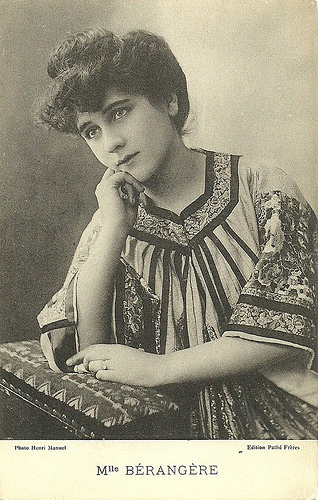
Jeanne Bérangère. French postcard by Edition Pathé Frères. Photo: Henri Manuel. A difficulty with this card, which is easily found online as well, is that it dates from around 1910-1914. French stage and screen actress Jeanne Bérangère (1864-1927) was born in 1864, so in 1914 she must have been around 50. And the woman on the postcard seems much younger. We could not trace whether Pathé used a pre-1900 photo, a photo of a relative with the same name (a daughter?), or just a photo of somebody else.
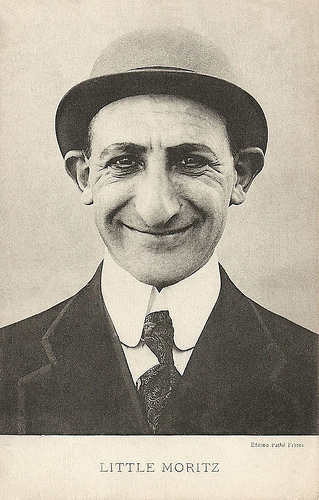
Little Moritz. French postcard by Edition Pathé Frères.
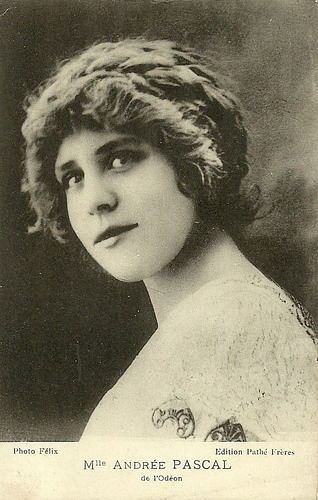
Andrée Pascal. French postcard by Edition Pathé Frères. Photo: Félix.
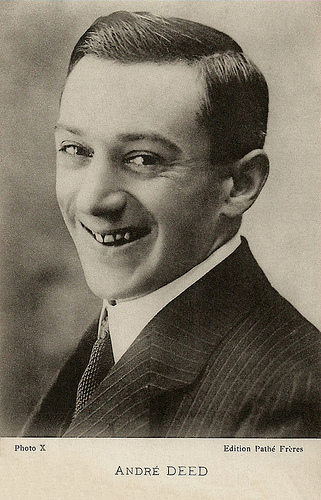
André Deed . French postcard by Edition Pathé Frères. Photo: X.
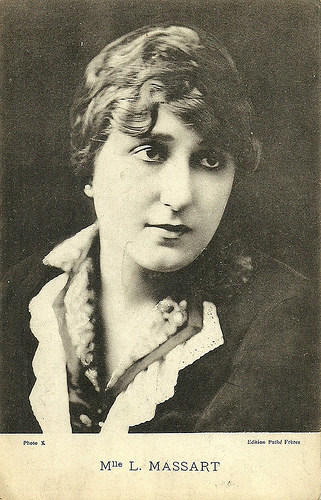
Léontine Massart . French postcard by Edition Pathé Frères. Photo: X.
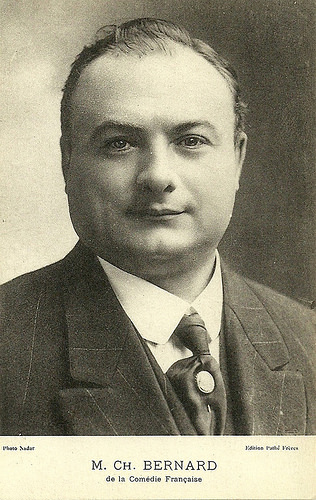
Léon Bernard . French postcard by Edition Pathé Frères. Photo: Nadar. The Ch. must be a mistake, as this is clearly French stage and screen actor and also theatre director Léon Bernard .
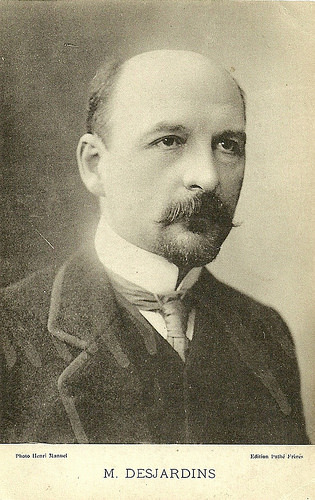
Maxime Desjardins . French postcard by Edition Pathé Frères. Photo: Henri Manuel.
One of the first feature-length films about Jesus
In 1896, Pathé Frères began using the camera developed by the Lumière brothers and then Pathé set about to design an improved studio camera and to make their own film stock. From 1901, Pathé teamed up with director and later manager Ferdinand Zecca who oversaw the creation and production of original Pathé Frères films.
Pathé opened sales agencies all over the world, selling projectors, films and equipment. In 1902 it opened a glass house studio near Paris, in 1904 two other ones. At Joinville-le-Pont, also near Paris, a series of factories were built to produce cameras and projectors and to develop film stock, with a separate section for colouring films.
From 1905 on, the company employed a specialised studio staff: screenwriters, directors, cinematographers and other technicians. In 1905 Pathé produced some 12.000 meters film stock per month of positive film, by now mostly fiction films. Zecca explored many themes from the mundane to the fantastic. In À la conquête de l'air/Conquering the Skies (Ferdinand Zecca, 1901), a strange flying machine, called Fend-l'air, was seen flying over the rooftops of Belleville. By using trick photography, the one-minute short was notable in being the first aviation film, predating the flight by the Wright Brothers by two years.
Zecca also pioneered with one of the first crime dramas, Histoire d'un crime/History of a Crime (Ferdinand Zecca, 1901), stylistically innovative in its use of superimposition. The story was of a man condemned to death, awaiting execution with his crimes appearing on his cell wall. The film is an early example of flashbacks as a film device. Other Pathé films included comedies, trick films or fairy tales, such as Les Sept châteaux du Diable/The Seven Castles of the Devil (Ferdinand Zecca, 1901), and La Belle au bois dormant/Sleeping Beauty (1902).
Pathé also produced social dramas like Les Victimes de l'alcoolisme/Alcohol and Its Victims (Ferdinand Zecca, 1902), Au pays noir/Down in the Coal Mines (Lucien Nonguet, Ferdinand Zecca, 1905) and reconstructions of actual events, the most famous being La Catastrophe de la Martinique/Martinique Disaster (Ferdinand Zecca, 1902). Zecca also acted in many of his films.
Between 1900 and 1907, Zecca oversaw the production of hundreds of Pathé films from many important Pathé directors including Lucien Nonguet, Gaston Velle, Albert Capellani, Louis J. Gasnier, André Heuzé and Henri Pouctal. Zecca also acted, directed, produced, and, on occasion, wrote films. These films were at most 300 meters in length, so max. 15 minutes of screening time (which is already quite longer than the single take films of Lumière, and consisted of various shots edited together).
La Vie et la passion de Jésus Christ/Life and Passion of the Christ (Lucien Nonguet, Ferdinand Zecca, 1903) was, at a running time of 44 minutes, one of the first feature-length films about Jesus. Production grew massively: in 1906 the output of positive film stock tripled that of the year before. In 1906, Spaniard Segundo de Chomón arrived at the Pathé studio and assisted Zecca with photography and special effects. He started to colour films, such as Vie et Passion de N.S. Jésus Christ/Life and Passion of Christ (Ferdinand Zecca, 1907), shot in four parts with 38 scenes, 990 metres long. At first, the films were hand-coloured, and later semi-mechanically coloured with stencils, a method also used for colouring postcards.
After Pathé bought the rights to George Méliès's Star films, Zecca started editing the Méliès films. Film production went from 70 titles in 1901 to 500 in 1903. After 1906, the mass film production gradually eased as longer films were produced. Pathé and Méliès started to work together in 1911. Georges Méliès's first film to be distributed by Pathé was the fantasy-comedy Les aventures de baron de Munchhausen/Baron Munchausen's Dream (Georges Méliès, 1911).
Pathé Frères filmed numerous short subjects, the majority of which are sensational criminal adventures, melodramatic love stories, and comedies. In 1912 Pathé produced its first feature film, Les Misérables (Albert Capellani, 1912), a four-reel screen version of the novel by Victor Hugo starring Henry Krauss as Jean Valjean and Maria Fromet as Cosette. In 1912, Pathé appointed Alfred Machin to develop the first studio films at Sint-Jans-Molenbeek, Château Karreveld, Belgium. And in 1914, Pathé Frères studios in the United States released the first episodes of The Perils of Pauline (Louis J. Gasnier, Donald MacKenzie, 1914) featuring Pearl White, one of the earliest and best remembered screen serials.
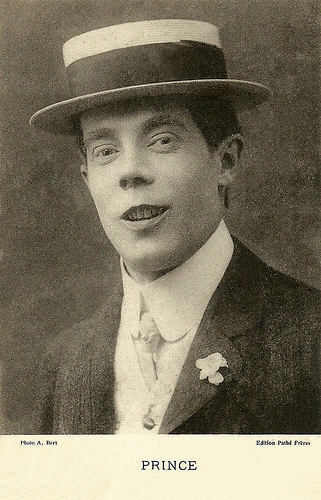
Charles Prince . French postcard by Edition Pathé Frères. Photo: A. Bert.
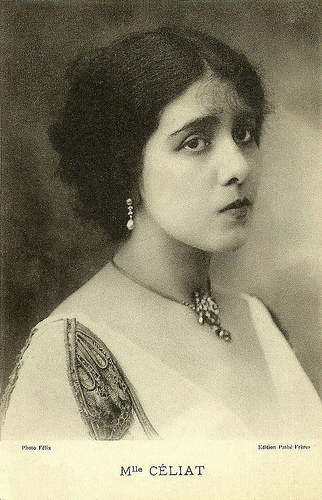
Madeleine Céliat . French postcard by Edition Pathé Frères. Photo: Félix.
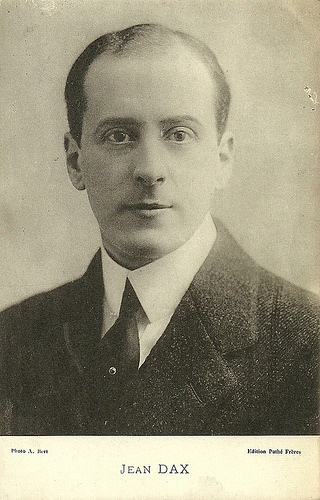
Jean Dax . French postcard by Edition Pathé Frères. Photo: A. Bert.
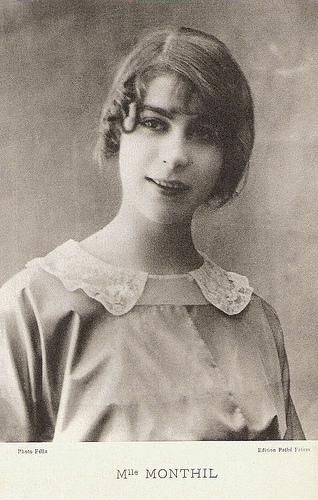
Marcelle Monthil . French postcard by Edition Pathé Frères. Photo: Félix.
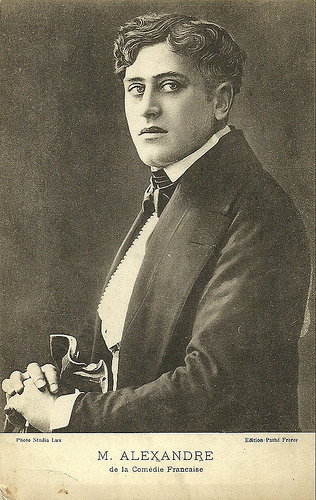
René Alexandre . French postcard by Edition Pathé Frères. Photo: Studio Lux.
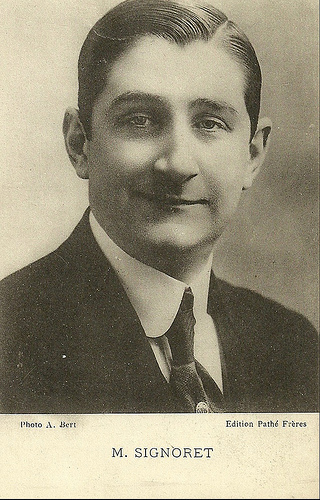
Gabriel Signoret . French postcard by Edition Pathé Frères. Photo: A. Bert.
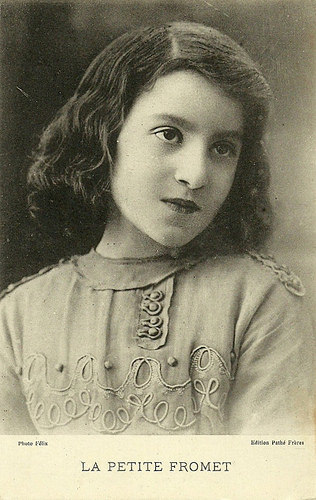
Maria Fromet . French postcard by Edition Pathé Frères. Photo: Félix.
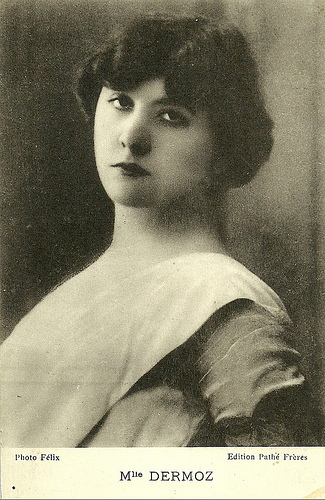
Germaine Dermoz. French postcard by Edition Pathé Frères. Photo: Félix.
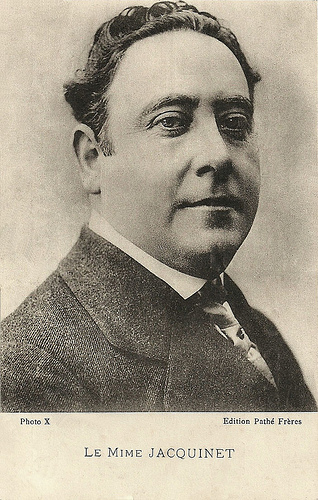
Jean Jacquinet (Le mime Jacquinet). French postcard by Edition Pathé Frères. On the back imprint, publicity for the West-Java Bioscope at Senen (now part of Jakarta), Dutch East Indies (now Indonesia).
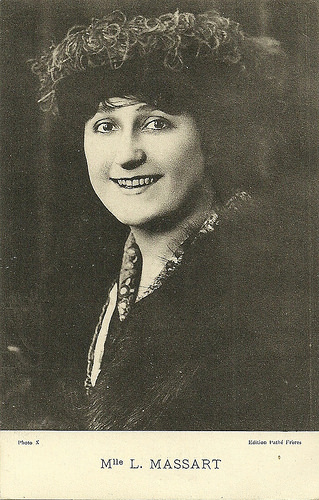
Léontine Massart . French postcard by Edition Pathé Frères. Photo: X.
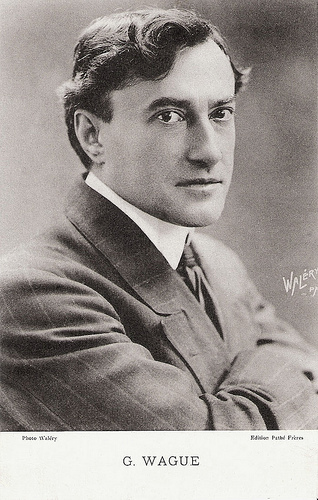
Georges Wague . French postcard by Edition Pathé Frères. Photo: Waléry, Paris.
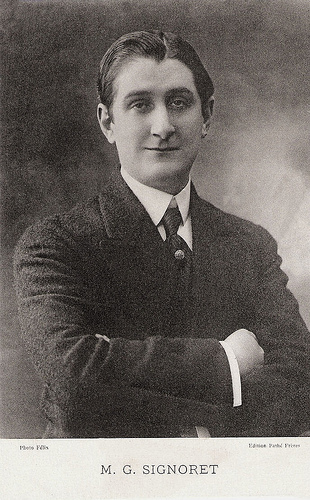
Gabriel Signoret . French postcard by Edition Pathé Frères. Photo: Félix.
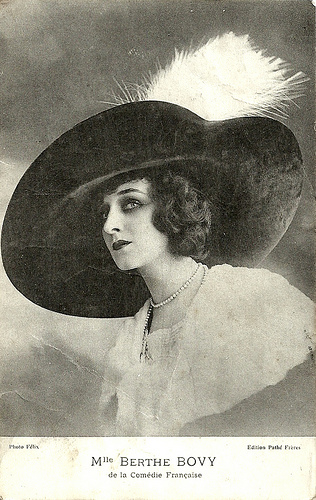
Berthe Bovy . French postcard by Edition Pathé Frères. Photo: Félix. Caption: Mlle Berthe Bovy of the Comédie Française.
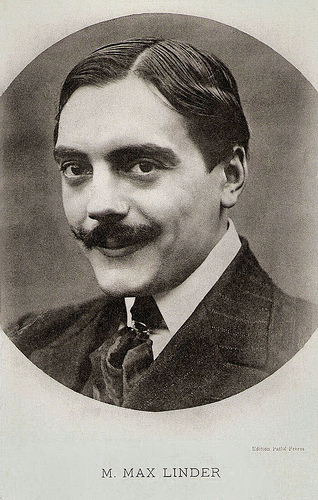
Max Linder . French postcard by Edition Pathé Frères.

Check out other postcard blogs
at Postcard Friendship Friday!
Sources: Wikipedia, Eyefilm and .

Jeanne Bérangère. French postcard by Edition Pathé Frères. Photo: Henri Manuel. A difficulty with this card, which is easily found online as well, is that it dates from around 1910-1914. French stage and screen actress Jeanne Bérangère (1864-1927) was born in 1864, so in 1914 she must have been around 50. And the woman on the postcard seems much younger. We could not trace whether Pathé used a pre-1900 photo, a photo of a relative with the same name (a daughter?), or just a photo of somebody else.

Little Moritz. French postcard by Edition Pathé Frères.

Andrée Pascal. French postcard by Edition Pathé Frères. Photo: Félix.

André Deed . French postcard by Edition Pathé Frères. Photo: X.

Léontine Massart . French postcard by Edition Pathé Frères. Photo: X.

Léon Bernard . French postcard by Edition Pathé Frères. Photo: Nadar. The Ch. must be a mistake, as this is clearly French stage and screen actor and also theatre director Léon Bernard .

Maxime Desjardins . French postcard by Edition Pathé Frères. Photo: Henri Manuel.
One of the first feature-length films about Jesus
In 1896, Pathé Frères began using the camera developed by the Lumière brothers and then Pathé set about to design an improved studio camera and to make their own film stock. From 1901, Pathé teamed up with director and later manager Ferdinand Zecca who oversaw the creation and production of original Pathé Frères films.
Pathé opened sales agencies all over the world, selling projectors, films and equipment. In 1902 it opened a glass house studio near Paris, in 1904 two other ones. At Joinville-le-Pont, also near Paris, a series of factories were built to produce cameras and projectors and to develop film stock, with a separate section for colouring films.
From 1905 on, the company employed a specialised studio staff: screenwriters, directors, cinematographers and other technicians. In 1905 Pathé produced some 12.000 meters film stock per month of positive film, by now mostly fiction films. Zecca explored many themes from the mundane to the fantastic. In À la conquête de l'air/Conquering the Skies (Ferdinand Zecca, 1901), a strange flying machine, called Fend-l'air, was seen flying over the rooftops of Belleville. By using trick photography, the one-minute short was notable in being the first aviation film, predating the flight by the Wright Brothers by two years.
Zecca also pioneered with one of the first crime dramas, Histoire d'un crime/History of a Crime (Ferdinand Zecca, 1901), stylistically innovative in its use of superimposition. The story was of a man condemned to death, awaiting execution with his crimes appearing on his cell wall. The film is an early example of flashbacks as a film device. Other Pathé films included comedies, trick films or fairy tales, such as Les Sept châteaux du Diable/The Seven Castles of the Devil (Ferdinand Zecca, 1901), and La Belle au bois dormant/Sleeping Beauty (1902).
Pathé also produced social dramas like Les Victimes de l'alcoolisme/Alcohol and Its Victims (Ferdinand Zecca, 1902), Au pays noir/Down in the Coal Mines (Lucien Nonguet, Ferdinand Zecca, 1905) and reconstructions of actual events, the most famous being La Catastrophe de la Martinique/Martinique Disaster (Ferdinand Zecca, 1902). Zecca also acted in many of his films.
Between 1900 and 1907, Zecca oversaw the production of hundreds of Pathé films from many important Pathé directors including Lucien Nonguet, Gaston Velle, Albert Capellani, Louis J. Gasnier, André Heuzé and Henri Pouctal. Zecca also acted, directed, produced, and, on occasion, wrote films. These films were at most 300 meters in length, so max. 15 minutes of screening time (which is already quite longer than the single take films of Lumière, and consisted of various shots edited together).
La Vie et la passion de Jésus Christ/Life and Passion of the Christ (Lucien Nonguet, Ferdinand Zecca, 1903) was, at a running time of 44 minutes, one of the first feature-length films about Jesus. Production grew massively: in 1906 the output of positive film stock tripled that of the year before. In 1906, Spaniard Segundo de Chomón arrived at the Pathé studio and assisted Zecca with photography and special effects. He started to colour films, such as Vie et Passion de N.S. Jésus Christ/Life and Passion of Christ (Ferdinand Zecca, 1907), shot in four parts with 38 scenes, 990 metres long. At first, the films were hand-coloured, and later semi-mechanically coloured with stencils, a method also used for colouring postcards.
After Pathé bought the rights to George Méliès's Star films, Zecca started editing the Méliès films. Film production went from 70 titles in 1901 to 500 in 1903. After 1906, the mass film production gradually eased as longer films were produced. Pathé and Méliès started to work together in 1911. Georges Méliès's first film to be distributed by Pathé was the fantasy-comedy Les aventures de baron de Munchhausen/Baron Munchausen's Dream (Georges Méliès, 1911).
Pathé Frères filmed numerous short subjects, the majority of which are sensational criminal adventures, melodramatic love stories, and comedies. In 1912 Pathé produced its first feature film, Les Misérables (Albert Capellani, 1912), a four-reel screen version of the novel by Victor Hugo starring Henry Krauss as Jean Valjean and Maria Fromet as Cosette. In 1912, Pathé appointed Alfred Machin to develop the first studio films at Sint-Jans-Molenbeek, Château Karreveld, Belgium. And in 1914, Pathé Frères studios in the United States released the first episodes of The Perils of Pauline (Louis J. Gasnier, Donald MacKenzie, 1914) featuring Pearl White, one of the earliest and best remembered screen serials.

Charles Prince . French postcard by Edition Pathé Frères. Photo: A. Bert.

Madeleine Céliat . French postcard by Edition Pathé Frères. Photo: Félix.

Jean Dax . French postcard by Edition Pathé Frères. Photo: A. Bert.

Marcelle Monthil . French postcard by Edition Pathé Frères. Photo: Félix.

René Alexandre . French postcard by Edition Pathé Frères. Photo: Studio Lux.

Gabriel Signoret . French postcard by Edition Pathé Frères. Photo: A. Bert.

Maria Fromet . French postcard by Edition Pathé Frères. Photo: Félix.

Germaine Dermoz. French postcard by Edition Pathé Frères. Photo: Félix.

Jean Jacquinet (Le mime Jacquinet). French postcard by Edition Pathé Frères. On the back imprint, publicity for the West-Java Bioscope at Senen (now part of Jakarta), Dutch East Indies (now Indonesia).

Léontine Massart . French postcard by Edition Pathé Frères. Photo: X.

Georges Wague . French postcard by Edition Pathé Frères. Photo: Waléry, Paris.

Gabriel Signoret . French postcard by Edition Pathé Frères. Photo: Félix.

Berthe Bovy . French postcard by Edition Pathé Frères. Photo: Félix. Caption: Mlle Berthe Bovy of the Comédie Française.

Max Linder . French postcard by Edition Pathé Frères.

Check out other postcard blogs
at Postcard Friendship Friday!
Sources: Wikipedia, Eyefilm and .
Published on November 03, 2017 23:00
November 2, 2017
Hilde Wörner
Hilde Wörner (1895-1963) was a German stage and film actress, who also worked as a filmmaker. She appeared mainly in silent films, had her own series and her most notable film was Ernst Lubitsch’s Die Flamme (1922).
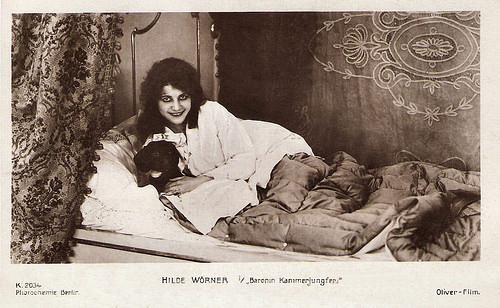
German postcard by Photochemie, no. K. 2034. Photo: Oliver-Film. Publicity still for Baronin Kammerjungfer/Baroness Kammerjungfer (Leo Peukert, 1917).
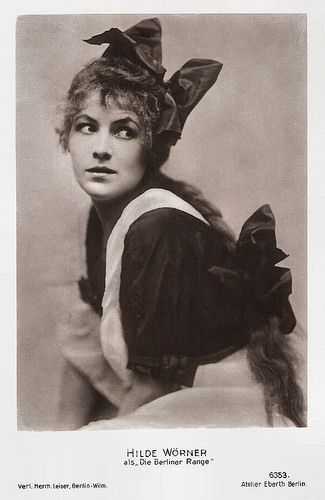
German postcard by Verlag Hermann Leiser, Berlin, no. 6253. Photo: Atelier Eberth, Berlin. Publicity still for Die Berliner Range/The Berlin Urchin (Carl Müller-Hagen, 1919-1921).
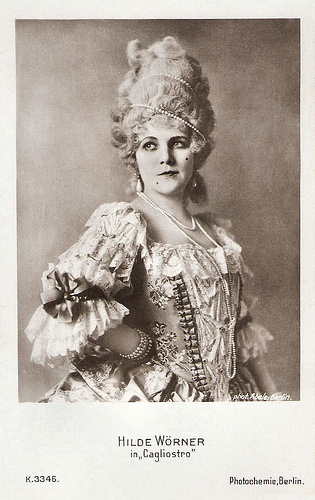
German postcard by Photochemie, no. K. 3346. Photo Abele, Berlin. Hilde Wörner in the German-Austrian coproduction Der Graf von Cagliostro (Reinhold Schünzel, 1919-1920).
The highest thing a film diva strives for
Hilde Wörner was born as Hilde Wörner-Lichtenstein.in 1895. The place of birth is unknown.
At 16, Wörner began her stage career in Elberfeld (toady a part of Wuppertal). In 1912, Johannes Maurach brought her to the Stadttheater in Essen. Later followed engagements at the theatres of Oldenburg and Bremen.
In the late phase of the First World War, she reached Berlin, where she succeeded Lisa Weise in the operetta ensemble of the Berliner Theater. There she was the first soubrette.
Almost at the same time, Heinrich Bolten-Baeckers, director of the Oliver Filmgesellschaft, signed her for the cinema. Wörner made her film debut in the silent film Baronin Kammerjungfer/Baroness Kammerjungfer (Leo Peukert, 1917). She immediately had the status of a ‘series star’. "This is the highest thing a film diva strives for," said Wörner in 1919.
She specialised in the role of youthful salon ladies and played in both dramas and comedies. However, according to German Wikipedia , she was regarded as a mediocre actress. In 1919, Hilde Wörner founded the Filmproduktionsgesellschaft Wörner-Film in Berlin, which produced various feature films until 1923.
At that time, Wörner was married to the silent film director Carl Müller-Hagen, who directed many of her films, such as the six-part series Die Berliner Range/The Berlin Urchin (1919-1921) and the crime costume drama Moriturus (1920) with Max Landa , as detective, Reinhold Schünzel in the title role, and Conrad Veidt as the criminal.
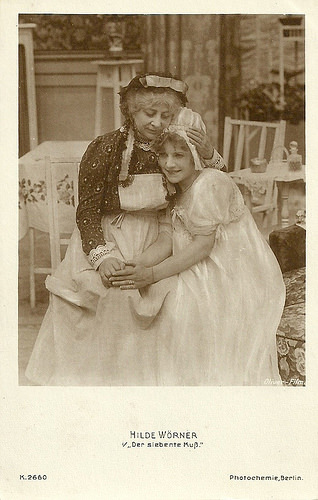
German postcard by Photochemie, no. K.2660. Photo: Oliver-Film. Hilde Wörner in Der siebente Kuß/The Seventh Kiss (1918). Director unknown.
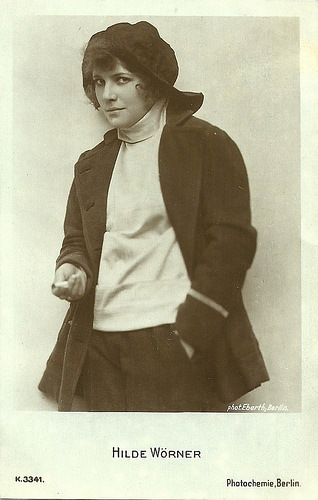
German postcard by Photochemie, no. K. 3341. Photo: Eberth, Berlin.
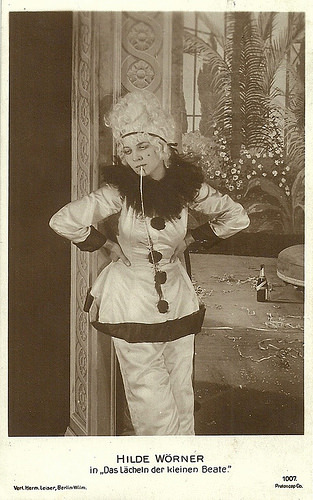
German postcard by Verlag Hermann Leiser, no. 1007. Photo: Protoscop Co. Hilde Wörner in Das Lächeln der kleinen Beate/The Smile of Little Beate (Georg Schubert, 1919).
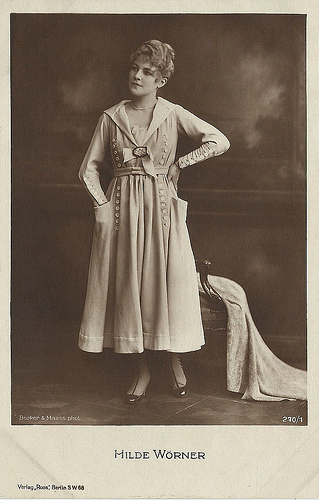
German postcard by Ross Verlag, Berlin, no. 270/1. Photo: Becker & Maass, Berlin. Collection: Didier Hanson.
Ernst Lubitsch's last German film
In 1920, Hilde Wörner appeared in the Austrian-German production Der Graf von Cagliostro/The Count of Cagliostro (Reinhold Schünzel, 1920), in which director Reinhold Schünzel played the role of the eighteenth century Italian adventurer Alessandro Cagliostro opposite Anita Berber and Conrad Veidt .
With her small film company she produced Russian director Dimitri Buchowetzki’s historical drama Danton (1921) with Emil Jannings as Danton and Werner Krauss as Robespierre. Based on the play Danton's Death by Georg Büchner, the film tells how during his reign of terror, Robespierre orchestrates the trial and execution of several of his fellow leading French revolutionaries including Georges Danton.
Wörner also produced his version of William Shakespeare’s Othello (Dimitri Buchowetzki, 1922), again with Emil Jannings and Werner Krauss .
At the side of Pola Negri , Wörner played the second female starring role in Die Flamme/The Flame/Montmartre (Ernst Lubitsch, 1923), which she also produced. It was Ernst Lubitsch 's last German film before he moved to Hollywood.
Then Wörner retired from the film business and continued to work in the theatre. In 1926, she returned seen in a supporting role in Rosen aus dem Süden/Roses from the south (Carl Froelich, 1926), starring Henny Porten .
In 1930, she appeared in small parts in two sound films, the musical comedy Einbrecher/Burglars (Hanns Schwarz, 1930) with Willy Fritsch and Lilian Harvey , and the historical film Das Flötenkonzert von Sans-souci/The Flute Concerto of Sans-Souci (Gustav Ucicky, 1930) starring Otto Gebühr as Friedrich II (aka Frederick the Great). It was part of the popular cycle of Prussian films.
It was her last film appearance. Wörner married tenor Eduard Lichtenstein and performed with him at the Metropol Theater in Berlin. After the rise of the Nazis, the Jewish Lichtenstein and his wife moved to the Netherlands where they lived in Amsterdam. In the summer of 1933, she appeared in Kabarett der Prominenten, founded by Willy Rose. She also played in Rosen’s comedy Der Chauffeur meiner Frau (My Wife's Chauffeur) in the Netherlands.
About what later happened to her is little known, but that she married the Dutch conductor Jan Koetsier. In 1949, she translated for him a musical play based on Frederik van Eeden’s play Frans Hals/Een vrolijk geval (Frans Hals – a cheerful case) into German.
Hilde Wörner passed away in 1963. She was 67.
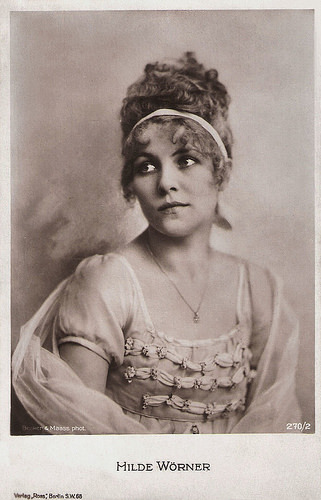
German postcard by Ross Verlag, no. 270/2, 1919-1924. Photo: Becker & Maass.
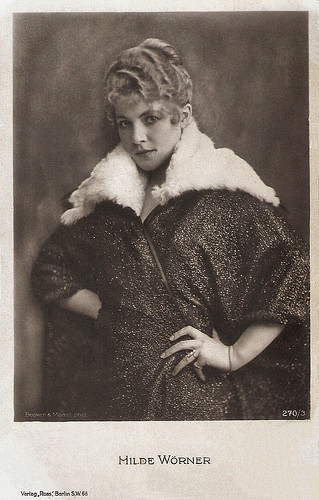
German postcard by Ross Verlag, no. 270/3, 1919-1924. Photo: Becker & Maass.
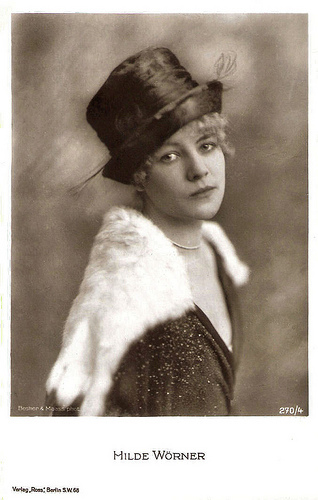
German postcard by Ross Verlag, no. 270/4, 1919-1924. Photo: Becker & Maass.
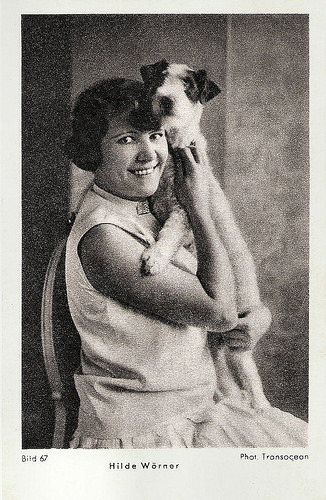
German postcard by Margarinewerk Eidelstedt Gebr. Fauser G.m.b.H., Holstein, Serie 1, no. Bild 67. Photo: Transocean.
Sources: Stephanie D’heil (Steffie-line - German), Nederlands Muziek Instituut (Dutch and German), Wikipedia (German) and .

German postcard by Photochemie, no. K. 2034. Photo: Oliver-Film. Publicity still for Baronin Kammerjungfer/Baroness Kammerjungfer (Leo Peukert, 1917).

German postcard by Verlag Hermann Leiser, Berlin, no. 6253. Photo: Atelier Eberth, Berlin. Publicity still for Die Berliner Range/The Berlin Urchin (Carl Müller-Hagen, 1919-1921).

German postcard by Photochemie, no. K. 3346. Photo Abele, Berlin. Hilde Wörner in the German-Austrian coproduction Der Graf von Cagliostro (Reinhold Schünzel, 1919-1920).
The highest thing a film diva strives for
Hilde Wörner was born as Hilde Wörner-Lichtenstein.in 1895. The place of birth is unknown.
At 16, Wörner began her stage career in Elberfeld (toady a part of Wuppertal). In 1912, Johannes Maurach brought her to the Stadttheater in Essen. Later followed engagements at the theatres of Oldenburg and Bremen.
In the late phase of the First World War, she reached Berlin, where she succeeded Lisa Weise in the operetta ensemble of the Berliner Theater. There she was the first soubrette.
Almost at the same time, Heinrich Bolten-Baeckers, director of the Oliver Filmgesellschaft, signed her for the cinema. Wörner made her film debut in the silent film Baronin Kammerjungfer/Baroness Kammerjungfer (Leo Peukert, 1917). She immediately had the status of a ‘series star’. "This is the highest thing a film diva strives for," said Wörner in 1919.
She specialised in the role of youthful salon ladies and played in both dramas and comedies. However, according to German Wikipedia , she was regarded as a mediocre actress. In 1919, Hilde Wörner founded the Filmproduktionsgesellschaft Wörner-Film in Berlin, which produced various feature films until 1923.
At that time, Wörner was married to the silent film director Carl Müller-Hagen, who directed many of her films, such as the six-part series Die Berliner Range/The Berlin Urchin (1919-1921) and the crime costume drama Moriturus (1920) with Max Landa , as detective, Reinhold Schünzel in the title role, and Conrad Veidt as the criminal.

German postcard by Photochemie, no. K.2660. Photo: Oliver-Film. Hilde Wörner in Der siebente Kuß/The Seventh Kiss (1918). Director unknown.

German postcard by Photochemie, no. K. 3341. Photo: Eberth, Berlin.

German postcard by Verlag Hermann Leiser, no. 1007. Photo: Protoscop Co. Hilde Wörner in Das Lächeln der kleinen Beate/The Smile of Little Beate (Georg Schubert, 1919).

German postcard by Ross Verlag, Berlin, no. 270/1. Photo: Becker & Maass, Berlin. Collection: Didier Hanson.
Ernst Lubitsch's last German film
In 1920, Hilde Wörner appeared in the Austrian-German production Der Graf von Cagliostro/The Count of Cagliostro (Reinhold Schünzel, 1920), in which director Reinhold Schünzel played the role of the eighteenth century Italian adventurer Alessandro Cagliostro opposite Anita Berber and Conrad Veidt .
With her small film company she produced Russian director Dimitri Buchowetzki’s historical drama Danton (1921) with Emil Jannings as Danton and Werner Krauss as Robespierre. Based on the play Danton's Death by Georg Büchner, the film tells how during his reign of terror, Robespierre orchestrates the trial and execution of several of his fellow leading French revolutionaries including Georges Danton.
Wörner also produced his version of William Shakespeare’s Othello (Dimitri Buchowetzki, 1922), again with Emil Jannings and Werner Krauss .
At the side of Pola Negri , Wörner played the second female starring role in Die Flamme/The Flame/Montmartre (Ernst Lubitsch, 1923), which she also produced. It was Ernst Lubitsch 's last German film before he moved to Hollywood.
Then Wörner retired from the film business and continued to work in the theatre. In 1926, she returned seen in a supporting role in Rosen aus dem Süden/Roses from the south (Carl Froelich, 1926), starring Henny Porten .
In 1930, she appeared in small parts in two sound films, the musical comedy Einbrecher/Burglars (Hanns Schwarz, 1930) with Willy Fritsch and Lilian Harvey , and the historical film Das Flötenkonzert von Sans-souci/The Flute Concerto of Sans-Souci (Gustav Ucicky, 1930) starring Otto Gebühr as Friedrich II (aka Frederick the Great). It was part of the popular cycle of Prussian films.
It was her last film appearance. Wörner married tenor Eduard Lichtenstein and performed with him at the Metropol Theater in Berlin. After the rise of the Nazis, the Jewish Lichtenstein and his wife moved to the Netherlands where they lived in Amsterdam. In the summer of 1933, she appeared in Kabarett der Prominenten, founded by Willy Rose. She also played in Rosen’s comedy Der Chauffeur meiner Frau (My Wife's Chauffeur) in the Netherlands.
About what later happened to her is little known, but that she married the Dutch conductor Jan Koetsier. In 1949, she translated for him a musical play based on Frederik van Eeden’s play Frans Hals/Een vrolijk geval (Frans Hals – a cheerful case) into German.
Hilde Wörner passed away in 1963. She was 67.

German postcard by Ross Verlag, no. 270/2, 1919-1924. Photo: Becker & Maass.

German postcard by Ross Verlag, no. 270/3, 1919-1924. Photo: Becker & Maass.

German postcard by Ross Verlag, no. 270/4, 1919-1924. Photo: Becker & Maass.

German postcard by Margarinewerk Eidelstedt Gebr. Fauser G.m.b.H., Holstein, Serie 1, no. Bild 67. Photo: Transocean.
Sources: Stephanie D’heil (Steffie-line - German), Nederlands Muziek Instituut (Dutch and German), Wikipedia (German) and .
Published on November 02, 2017 23:00
Paul van Yperen's Blog
- Paul van Yperen's profile
- 13 followers
Paul van Yperen isn't a Goodreads Author
(yet),
but they
do have a blog,
so here are some recent posts imported from
their feed.



